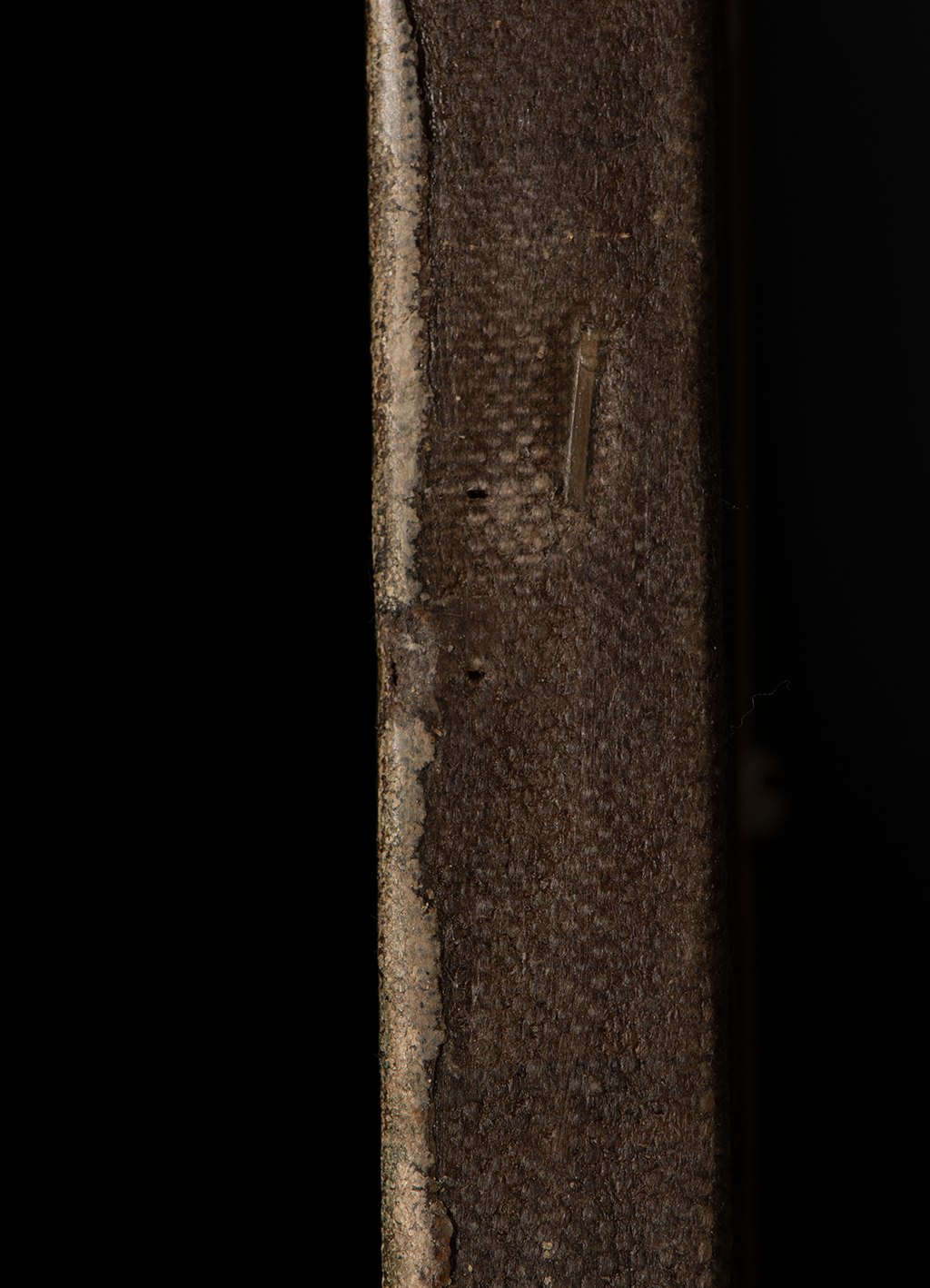![]()
Jean-François Millet, Waiting, ca. 1853–61
| Artist | Jean-François Millet, French, 1814–75 |
| Title | Waiting |
| Object Date | ca. 1853–61 |
| Alternate and Variant Titles | L’Attente; Tobit and Sara watching for the Return of Tobias; Tobie |
| Medium | Oil on canvas |
| Dimensions (Unframed) | 33 x 47 15/16 in. (83.8 x 121.7 cm) |
| Signature | Signed lower right: J. F. Millet. |
| Credit Line | The Nelson-Atkins Museum of Art. Purchase: William Rockhill Nelson Trust, 30-18 |
Catalogue Entry
Citation
Chicago:
Simon Kelly, “Jean-François Millet, Waiting, ca. 1853–61,” catalogue entry in French Paintings and Pastels, 1600–1945: The Collections of The Nelson-Atkins Museum of Art, ed. Aimee Marcereau DeGalan (Kansas City: The Nelson-Atkins Museum of Art, 2022), https://doi.org/10.37764/78973.5.528.5407.
MLA:
Kelly, Simon. “Jean-François Millet, Waiting, ca. 1853–61,” catalogue entry. French Paintings and Pastels, 1600–1945: The Collections of The Nelson-Atkins Museum of Art, edited by Aimee Marcereau DeGalan, Nelson-Atkins Museum of Art, 2022. doi: 10.37764/78973.5.528.5407.
Waiting shows a poignant scene from the book of Tobit.1Tobit chapters 4–6, 10, 11, especially 10:7, New Revised Standard Version, Anglicised Catholic Edition. Catholic and Orthodox traditions include Tobit as part of their canon of scripture, but it is noncanonical for Jews and Protestants. In chapter 11, after Tobias returns from collecting the debt, he restores his father’s sight with a cure provided by the angel Raphael. For an overview of this painting, see Simon Kelly, “Jean-François Millet’s ‘Waiting’: a ‘realist’ religious painting,’” Burlington Magazine 151, no. 1274 (May 2009): 298–305. For more about Millet, see Étienne Moreau-Nélaton, Millet raconté par lui-même, 3 vols. (Paris: Henri Laurens, 1921); Robert Herbert, Jean-François Millet, exh. cat. (London: Arts Council of Great Britain, 1975); Alexandra R. Murphy et al., Jean-François Millet, Drawn into the Light (New Haven: Yale University Press, 1999); and Chantal Georgel, Millet (Paris: Citadelles et Mazenod, 2014). The aged Anna looks into the distance in the hope of seeing the return of her son, Tobias, who had departed months prior to recover a debt. Her husband, Tobit, who is blind, emerges from the doorway of a stone cottage, his mouth open, his right foot hesitantly extended, and his left hand grasping the door lintel nervously to steady himself. Alongside, a ginger cat on a stone bench arches it back, perhaps yawning after a late afternoon nap, or perhaps, as its straightened tail suggests, hissing at an unseen creature in the foreground. At one side of the house, several sheep peek their heads through a fold directly adjoining the living space of their owners. In the distance, crows have come to roost on trees silhouetted against the light of the setting sun. Jean-François Millet’s picture highlights his abilities as a colorist through accents such as the red of Tobit’s waistcoat, the turquoise moss on the doorjambs and ground, and the far-off clouds, tinged with pink. The artist’s red-brown imprimaturaimprimatura: A thin layer of paint applied over the ground layer to establish an overall tonality. layer also forms an important and visible element in the final composition, notably in the face and hands of Tobit.
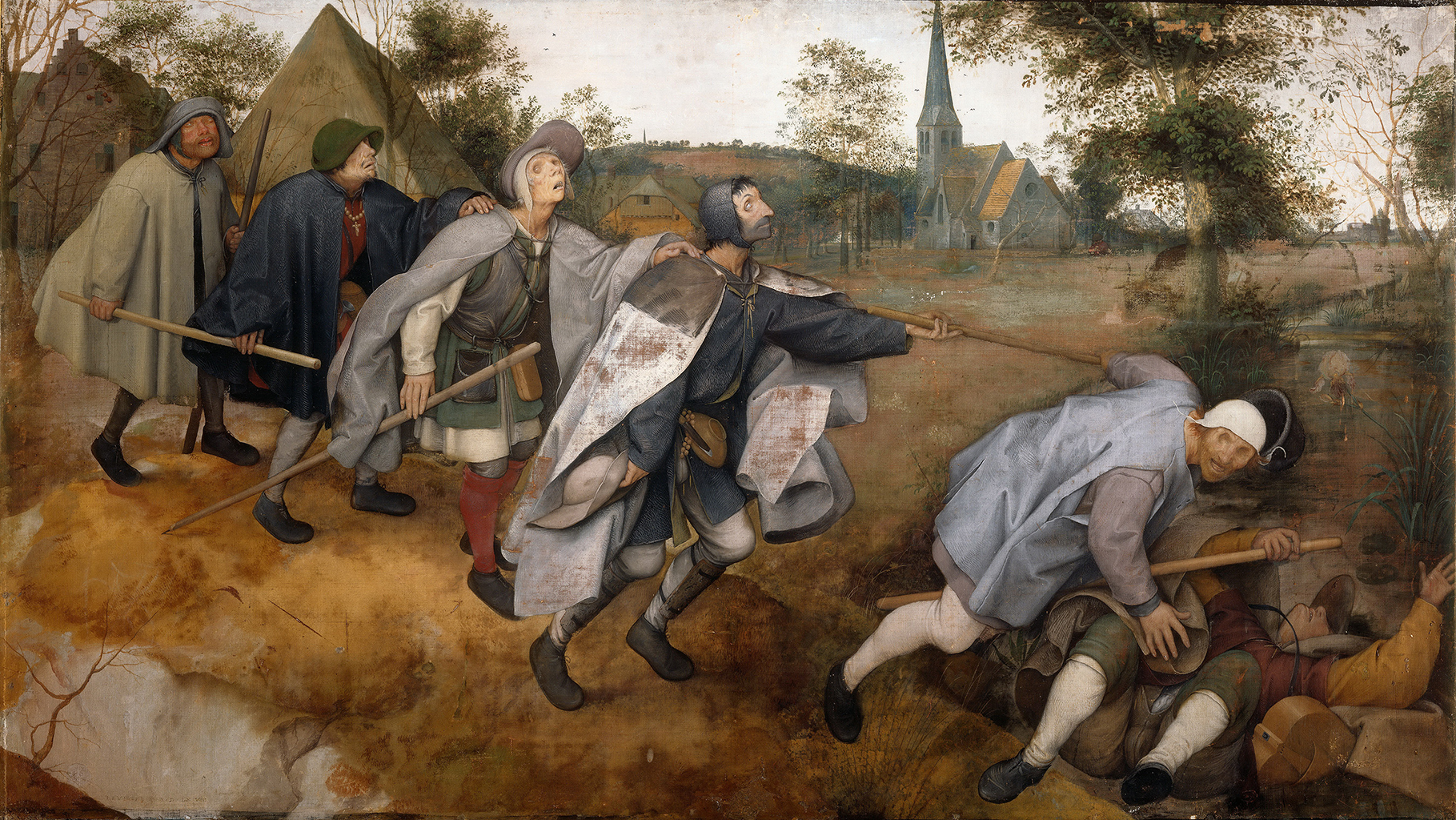
According to Millet’s friend and early biographer, Alfred Sensier, the genesis of Waiting lay in a very personal narrative.7Sensier, La Vie et L’Œuvre de J.-F. Millet, 137. Millet’s mother, in poor health, wrote to him in the early 1850s, urging that he return to his birthplace of Gruchy to see her. Preoccupied with his financial affairs and artistic ambitions in Paris and Barbizon, he did not do so, and in April 1853, his mother died. Millet was apparently overcome with remorse and, as a way of dealing with his pain, sketched out this painting as a kind of memorial to his mother, seeing her yearning for his return paralleled in the biblical story.8“Il ébauchait une scène où deux vieilles gens interrogent le ciel, cherchant à reconnaître à l’horizon une forme humaine au milieu des splendeurs d’un soleil couchant” (He was sketching out a scene where two old people question the sky, trying to recognize a human form on the horizon amidst the splendors of a setting sun). Sensier, La Vie et L’Œuvre de J.-F. Millet, 137. Soon after he began his work, an Alsatian collector, Frédéric Hartmann, showed interest in buying the painting. See Louis Campredon to Millet, February 3, 1854, Musée du Louvre, Paris, Département des Arts Graphiques, Aut. 2416. Millet’s preoccupation with the Bible at this time is also evident in a journal entry by Eugène Delacroix (1798–1863) from April 16, 1853: “In the morning, Millet visited me. . . . He speaks of Michelangelo and the Bible, which is, he says, more or less the only book he reads.”9“Dans la matinée, on m’a amené Millet. . . . Il parle de Michel-Ange et de la Bible, qui est, dit-il, le seul livre qu’il lise ou à peu près.” Eugène Delacroix, Journal de Delacroix, ed. Paul Flat and René Piot (Paris: Plon, 1893), 2:160–61. All translations are my own unless otherwise noted. Sensier noted that Millet worked on the picture in 1855 when the composition “was laid out and in a very advanced stage of the first draft.”10“L’année 1855 fut assez heureuse pour Millet. . . . L’Attente . . . fut dessinée et très avancée du premier coup.” Sensier, La Vie et L’Œuvre de J.-F. Millet, 161. For unclear reasons, Millet put Waiting to one side and returned to it several years later in 1860, when it was listed in a contract of works, drawn up on March 14 of that year, for the Belgian dealer Arthur Stevens.11Moreau-Nélaton, Millet raconté par lui-même, 2:73. Its significance in Millet’s output is indicated by the fact that it was given a price of three thousand francs, the highest of all the paintings listed in the contract. On May 2, 1860, Millet told his close friend, the landscape painter Théodore Rousseau (1812–67), that he was “working like mad” on the picture.12See Millet to Théodore Rousseau, May 2, 1860, Musée du Louvre, Paris, Département des Arts Graphiques, Aut. 1897. Sensier wrote that Millet “executed” the picture in 1860. “En 1860, il exécuta la Tondeuse, l’Attente, la Femme qui fait manger son enfant” (“In 1860, he executed the Mower, the Waiting, the Woman who feeds her child”); Sensier, La Vie et L’Œuvre de J.-F. Millet, 206. Although Millet began the work in 1853, as already noted, it is probable that he continued to work on the picture until he exhibited it at the Salon in 1861. Moreau-Nélaton dated the picture to 1861; Moreau-Nélaton, Millet raconté par lui-même, 2:1–2.
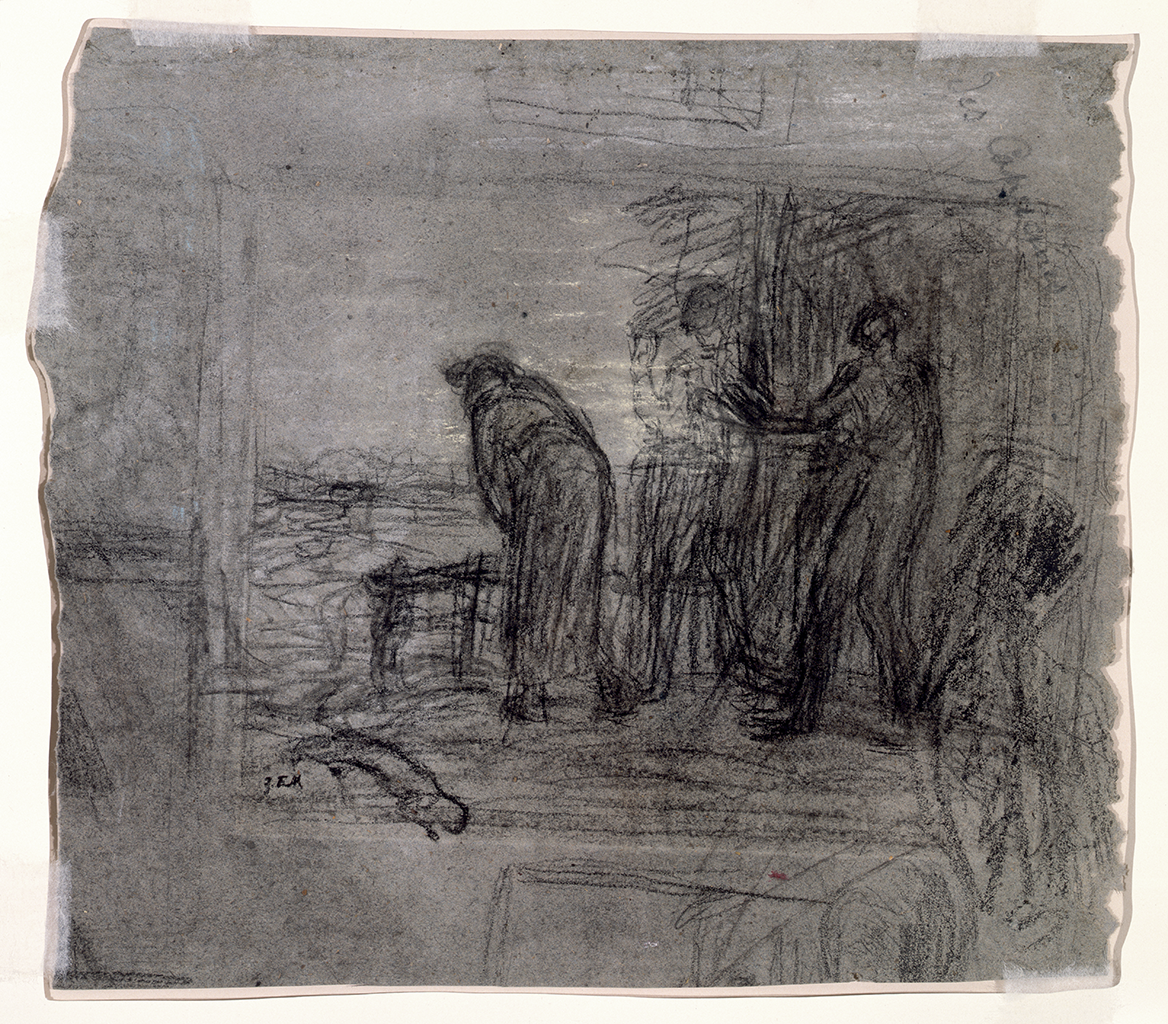 Fig. 2. Jean-François Millet, verso: Study for “Waiting” (The Parents of Tobias Awaiting his Return), ca. 1853–54, charcoal and pastel on blue-gray paper, 10 5/8 x 12 in. (27 x 30.5 cm), Santa Barbara Museum of Art, Gift of Dr. and Mrs. Edward L. Tuohy, 1959.31
Fig. 2. Jean-François Millet, verso: Study for “Waiting” (The Parents of Tobias Awaiting his Return), ca. 1853–54, charcoal and pastel on blue-gray paper, 10 5/8 x 12 in. (27 x 30.5 cm), Santa Barbara Museum of Art, Gift of Dr. and Mrs. Edward L. Tuohy, 1959.31
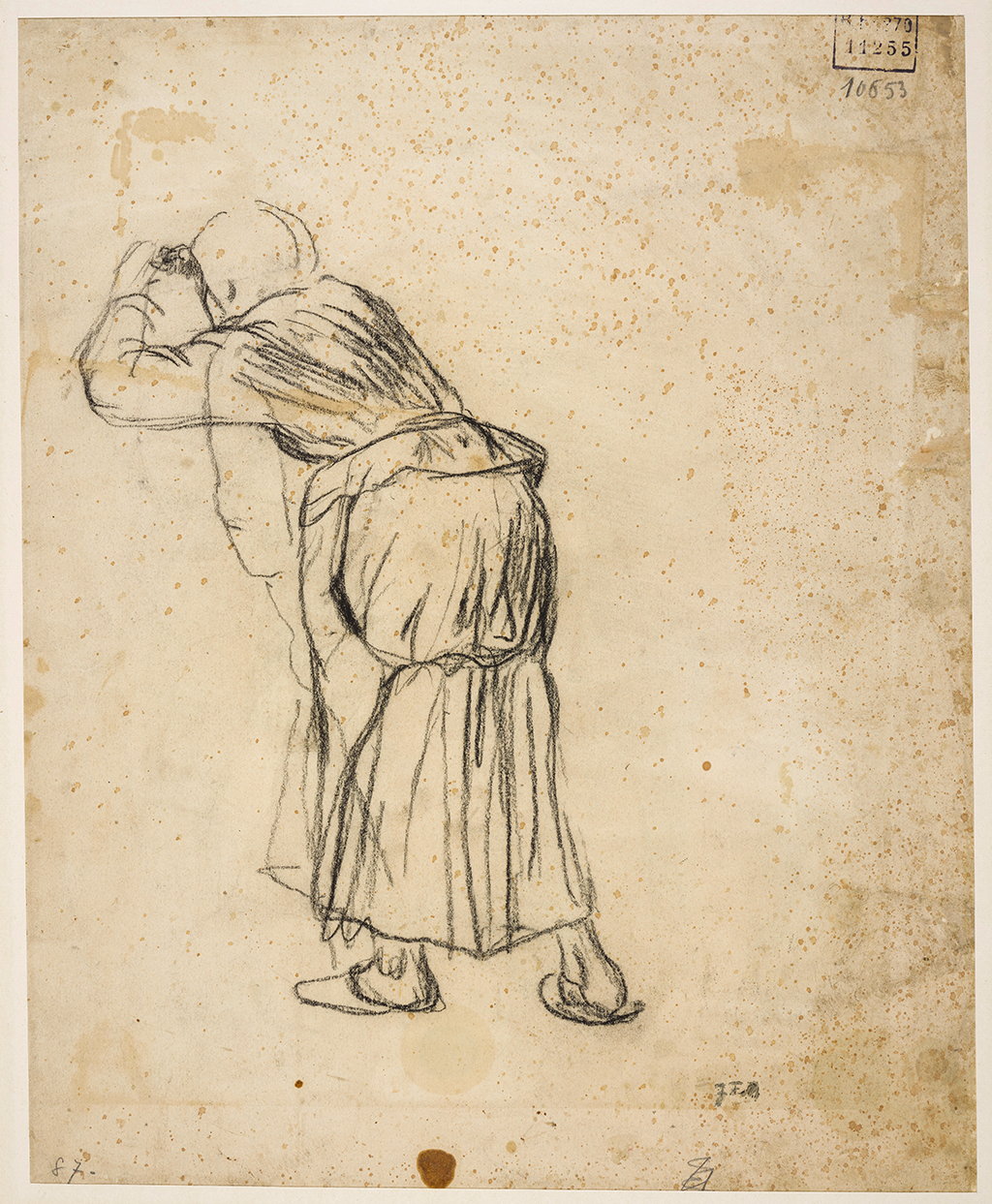 Fig. 3. Jean-François Millet, Standing Woman Seen from Behind, ca. 1860, black conté crayon on paper, 12 9/16 x 10 3/16 in. (31.9 x 25.8 cm), Département des Arts Graphiques, Musée du Louvre, Paris, RF 11255
Fig. 3. Jean-François Millet, Standing Woman Seen from Behind, ca. 1860, black conté crayon on paper, 12 9/16 x 10 3/16 in. (31.9 x 25.8 cm), Département des Arts Graphiques, Musée du Louvre, Paris, RF 11255
M. Millet had known me when I was very young. I was eighteen years old when he asked me to model for him: “Adèle,” he said to me one day, ‘will you pose like your father?” I accepted immediately. What would I not have done for so good a master? Then he brought me to his studio and put on my head a white cowl decorated with a black band, as we wore in times past for going to evening gatherings. . . . On that occasion, I posed for the wife of Tobit. The painting was called Waiting.13“M. Millet m’avait connue tout petite. J’avais dix-huit ans quand il me prit à son service: ‘Adèle,’ me dit-il un jour, ‘veux-tu poser comme ton père?’ J’acceptai tout de suite. Que je n’aurai-je fait pour un si bon maûtre? Alors, il m’emmena dans son atelier et me mit sur la tête un capuchon blanc orné d’une bande noire, comme on en portait jadis pour aller aux veillées. . . . Cette fois-là, je posai pour la femme de Tobie. Le tableau s’appelait L’Attente.” H. Petitjean, “Le Modèle de Millet,” Le Figaro 44, no. 270 (September 27, 1898): 3.
This testimony also indicates that Millet used Adèle’s father as the model for Tobit. Another drawing, a study of hands (Fig. 4), shows Millet’s interest in the use of gesture to communicate fully the helplessness of his blind protagonist. It contains three sketches of Tobit’s right hand, tightly grasping his cane, flanked by two of his left hand fumbling at the doorjamb.
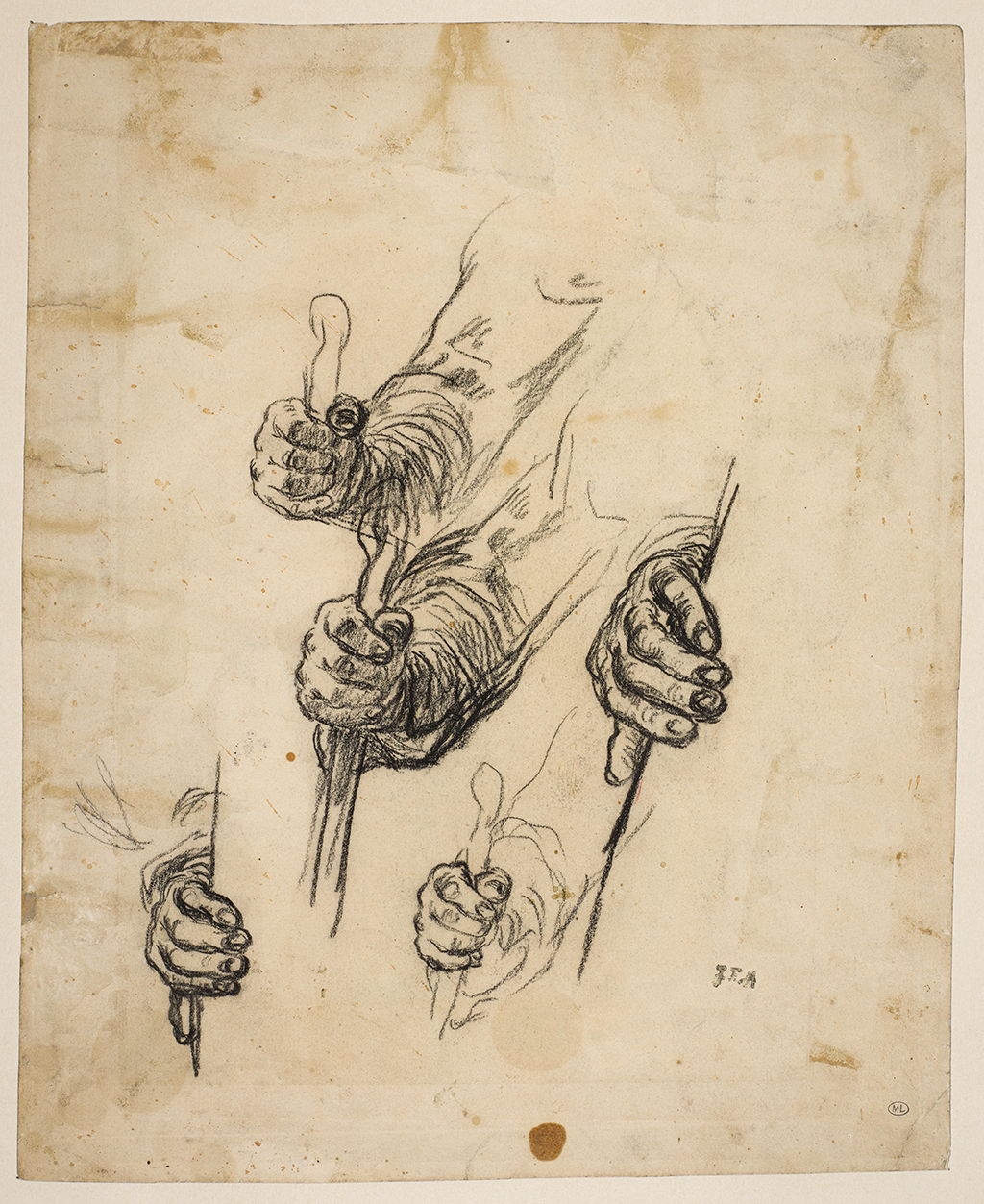
Waiting was the most controversial of Millet’s three entries at the Salon. The painting attracted some praise from Millet’s supporters.16For a more extensive discussion of the critical reception of the painting, see Kelly, “Jean-François Millet’s ‘Waiting,’” 302–05. The young critic Théodore Pelloquet noted that the work was marked by “a touching spirit, by a melancholic and tender feeling one cannot forget.”17“un caractère touchant . . . un sentiment mélancolique et attendri qu’on ne saurait oublier.” Théodore Pelloquet, “Salon de 1861,” Le Courrier du Dimanche (June 2, 1861): 5. The artist’s old friend Théophile Thoré-Burger noted that Anna was “masterfully constructed” and that “the pose of the old man [Tobit] is extraordinary, from head to toe.”18“magistralement charpentée. . . . La mimique du vieil aveugle est extraordinaire, de la tête aux pieds.” T[héophile] Thoré, Salons de W. Bürger, 1861 à 1868 (Paris: Jules Renouard, 1870), 1:98. However, the picture was the subject of repeated attacks by critics who found Millet’s treatment demeaning to the elevated biblical narrative. Some attacked the artist’s use of contemporary figures. Léon Lagrange wrote that the two protagonists looked like they were waiting for a bus at Barbizon.19Léon Lagrange, “Le Salon de 1861,” Gazette des Beaux-Arts 11 (July 1, 1861): 63. The satirists Félix Nadar and Henri-Alfred Darjou caricatured Millet’s “realist” laborers, exaggerating their ugliness (Fig. 5). Others also criticized his formal approach. Paul de Saint-Victor cited the “caricatural awkwardness” of his subjects and, moreover, compared Millet’s subversive treatment of the biblical theme to the “commercial religion” and “vulgar theology” of recently founded Mormonism.20“une gaucherie caricaturale” and “la théologie grossière des Mormons . . . cette religion commerciale . . . .” Paul de Saint-Victor, “Salon de 1861,” La Presse 26 (June 25, 1861): unpaginated. Saint-Victor continues: “il y a du mormonisme dans le tableau de M. Millet: c’est ainsi qu’un peintre du Lac Salé comprendrait et représenterait les scènes de la Bible” (“there is Mormonism in Mr. Millet’s painting: this is how a Salt Lake painter would understand and represent the scenes of the Bible”). Another critic, the comtesse de Rethel, wrote simply of “these awful paintings.”21“Ces affreux tableaux.” Comtesse de Rethel, “Exposition de peinture de 1861,” Journal des Dames et des Demoiselles 17, no. 12 (September 1861): 191. The artist himself apparently remained undeterred by such criticism, noting that “if I wore high heels, I might find it made the road rather heavy, but with sabots I think I can get out of the mire.”22Translation by Helena de Kay, in Sensier, Jean-François Millet. Peasant and Painter (Boston: James R. Osgood, 1880), 145. The original is recorded in Sensier*, La Vie et L’Œuvre de J.-F. Millet*, 217: “Si j’étais chaussé d’escarpins, je pourrais trouver que cela embarbouille un peu le chemin, mais, avec des sabots, je crois que je m’en tirerai.” Waiting may have encouraged Edouard Manet (1832–83)—whose realism represented an urban counterpart to Millet’s rural subjects—to paint a similarly agitated cat in his famed Olympia (1863; Musée d’Orsay, Paris).23The paintings by these two artists (since their names both began with M) were shown in the same room in 1861. See Kelly, “Jean-François Millet’s ‘Waiting,’” 301. Millet would go on to exhibit his controversial Man with a Hoe (1860–62; J. Paul Getty Museum, Los Angeles) at the next Salon, in 1863.
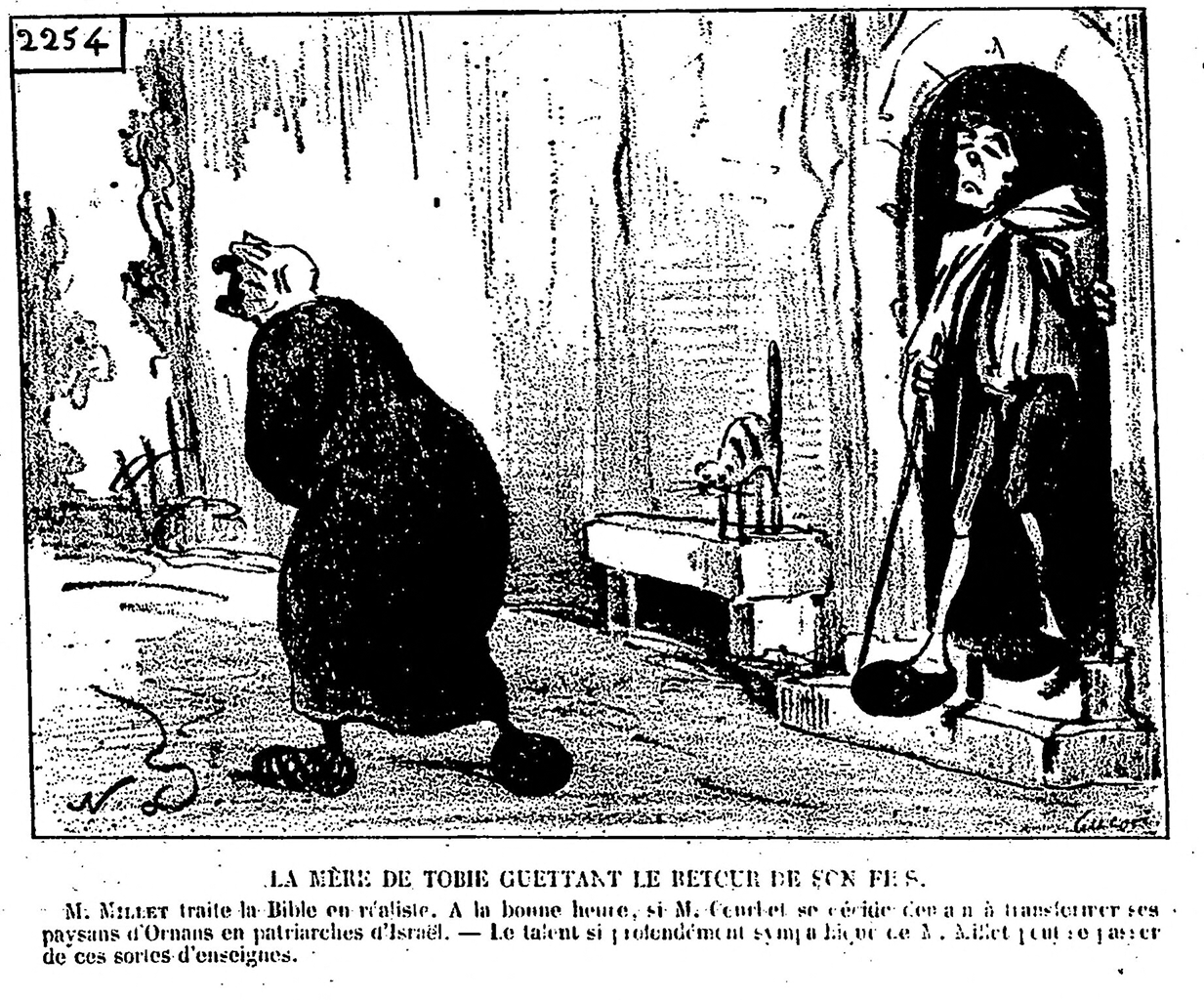
Notes
-
Tobit chapters 4–6, 10, 11, especially 10:7, New Revised Standard Version, Anglicised Catholic Edition. Catholic and Orthodox traditions include Tobit as part of their canon of scripture, but it is noncanonical for Jews and Protestants. In chapter 11, after Tobias returns from collecting the debt, he restores his father’s sight with a cure provided by the angel Raphael. For an overview of this painting, see Simon Kelly, “Jean-François Millet’s ‘Waiting’: a ‘realist’ religious painting,’” Burlington Magazine 151, no. 1274 (May 2009): 298–305. For more about Millet, see Étienne Moreau-Nélaton, Millet raconté par lui-même, 3 vols. (Paris: Henri Laurens, 1921); Robert Herbert, Jean-François Millet, exh. cat. (London: Arts Council of Great Britain, 1975); Alexandra R. Murphy et al., Jean-François Millet, Drawn into the Light (New Haven: Yale University Press, 1999); and Chantal Georgel, Millet (Paris: Citadelles et Mazenod, 2014).
-
Millet only made drawings for this commission, which, after his death, was awarded to Pierre Puvis de Chavannes (1824–98). See Alfred Sensier, La Vie et L’Œuvre de J.-F. Millet (Paris: A. Quantin, 1881), 361.
-
Kelly, “Jean-François Millet’s ‘Waiting,’” 300.
-
The five works by Bruegel the Elder in his paintings collection were The Gardeners (Les Jardiniers), The Skaters (Les Patineurs), A Kermis (Une Kermesse), Works of Mercy (Les Oeuvres de Miséricorde), and Village Festival (Fête villageoise). See Succession de Madame Veuve J. F. Millet. Dessins, Tableaux et Gravures par J. F. Millet (Paris: Hôtel Drouot, April 24–25, 1894), 51–52. These paintings have not yet been identified and, despite Millet’s belief in their authenticity, were undoubtedly copies made after the work of Bruegel the Elder.
-
This source was first noted by Robert Herbert in his essay “City vs. Country: The Rural Image in French Painting from Millet to Gauguin,” Artforum 8, no. 6 (February 1970); repr., Robert L. Herbert, Millet to Léger: Essays in Social Art History (New Haven: Yale University Press, 2002).
-
See “École de Brueghel, Wedding Banquet (Le Repas de Noces),” in Succession de Madame Veuve J. F. Millet, 52.
-
Sensier, La Vie et L’Œuvre de J.-F. Millet, 137.
-
“Il ébauchait une scène où deux vieilles gens interrogent le ciel, cherchant à reconnaître à l’horizon une forme humaine au milieu des splendeurs d’un soleil couchant” (He was sketching out a scene where two old people scan the sky, trying to recognize a human form on the horizon amidst the splendors of a setting sun). Sensier, La Vie et L’Œuvre de J.-F. Millet, 137. Soon after he began his work, an Alsatian collector, Frédéric Hartmann, showed interest in buying the painting. See Louis Campredon to Millet, February 3, 1854, Musée du Louvre, Paris, Département des Arts Graphiques, Aut. 2416.
-
“Dans la matinée, on m’a amené Millet. . . . Il parle de Michel-Ange et de la Bible, qui est, dit-il, le seul livre qu’il lise ou à peu près.” Eugène Delacroix, Journal de Delacroix, ed. Paul Flat and René Piot (Paris: Plon, 1893), 2:160–61. All translations are my own unless otherwise noted.
-
“L’année 1855 fut assez heureuse pour Millet. . . . L’Attente . . . fut dessinée et très avancée du premier coup.” Sensier, La Vie et L’Œuvre de J.-F. Millet, 161.
-
Moreau-Nélaton, Millet raconté par lui-même, 2:73.
-
See Millet to Théodore Rousseau, May 2, 1860, Musée du Louvre, Paris, Département des Arts Graphiques, Aut. 1897. Sensier wrote that Millet “executed” the picture in 1860. “En 1860, il exécuta la Tondeuse, l’Attente, la Femme qui fait manger son enfant” (In 1860, he executed the Mower, the Waiting, the Woman who feeds her child); Sensier, La Vie et L’Œuvre de J.-F. Millet, 206. Although Millet began the work in 1853, as already noted, it is probable that he continued to work on the picture until he exhibited it at the Salon in 1861. Moreau-Nélaton dated the picture to 1861; Moreau-Nélaton, Millet raconté par lui-même, 2:1–2.
-
“M. Millet m’avait connue tout petite. J’avais dix-huit ans quand il me prit à son service: ‘Adèle,’ me dit-il un jour, ‘veux-tu poser comme ton père?’ J’acceptai tout de suite. Que je n’aurai-je fait pour un si bon maûtre? Alors, il m’emmena dans son atelier et me mit sur la tête un capuchon blanc orné d’une bande noire, comme on en portait jadis pour aller aux veillées. . . . Cette fois-là, je posai pour la femme de Tobie. Le tableau s’appelait L’Attente.” H. Petitjean, “Le Modèle de Millet,” Le Figaro 44, no. 270 (September 27, 1898): 3.
-
“La Mère de Tobie ‘sortait avec empressement tous les jours de sa maison, regardant de tous côtés et allant dans tous les chemins par lesquels elle espérait qu’il pourrait revenir, pour tâcher de le découvrir de loin à son retour.’” Explication des Ouvrages de Peinture, Sculpture, Gravure, Lithographie et Architecture des Artistes Vivants, Exposés au Palais des Champs-Élysées le 1er Mai 1861, exh. cat. (Paris: Charles de Mourgues Frères, 1861); repr., in H. W. Janson, ed., Catalogues of the Paris Salon: 1673–1881, vol. 42, Paris Salon de 1861 (New York: Garland, 1977), 271.
-
“Si seulement M. de Chennevières peut me faire placer le Tobie à hauteur d’appui et dans un lieu ayant quelque lumière, ce sera déjà très beau.” Millet to Sensier, April 23, 1861, quoted in Sensier, La Vie et L’Œuvre de J.-F. Millet, 215.
-
For a more extensive discussion of the critical reception of the painting, see Kelly, “Jean-François Millet’s ‘Waiting,’” 302–05.
-
“un caractère touchant . . . un sentiment mélancolique et attendri qu’on ne saurait oublier.” Théodore Pelloquet, “Salon de 1861,” Le Courrier du Dimanche (June 2, 1861): 5.
-
“magistralement charpentée. . . . La mimique du vieil aveugle est extraordinaire, de la tête aux pieds.” T[héophile] Thoré, Salons de W. Bürger, 1861 à 1868 (Paris: Jules Renouard, 1870), 1:98.
-
Léon Lagrange, “Le Salon de 1861,” Gazette des Beaux-Arts 11 (July 1, 1861): 63.
-
“une gaucherie caricaturale” and “la théologie grossière des Mormons . . . cette religion commerciale . . . .” Paul de Saint-Victor, “Salon de 1861,” La Presse 26 (June 25, 1861): unpaginated. Saint-Victor continues: “il y a du mormonisme dans le tableau de M. Millet: c’est ainsi qu’un peintre du Lac Salé comprendrait et représenterait les scènes de la Bible” (there is Mormonism in Mr. Millet’s painting: this is how a Salt Lake painter would understand and represent the scenes of the Bible).
-
“Ces affreux tableaux.” Comtesse de Rethel, “Exposition de peinture de 1861,” Journal des Dames et des Demoiselles 17, no. 12 (September 1861): 191.
-
Translation by Helena de Kay, in Sensier, Jean-François Millet. Peasant and Painter (Boston: James R. Osgood, 1880), 145. The original is recorded in Sensier, La Vie et L’Œuvre de J.-F. Millet, 217: “Si j’étais chaussé d’escarpins, je pourrais trouver que cela embarbouille un peu le chemin, mais, avec des sabots, je crois que je m’en tirerai.”
-
The paintings by these two artists (since their names both began with M) were shown in the same room in 1861. See Kelly, “Jean-François Millet’s ‘Waiting,’” 301.
-
For more information on Sayles’s art collection, see Edward Strahan and George Barrie, The Art Treasures of America: Being the Choicest Works of Art in the Public and Private Collections of North America (Philadelphia: George Barrie, 1879), 93–94.
-
Seney’s earliest known date of ownership was October 27, 1886, when he lent the painting to Exhibition of Oil Paintings at the Reception in Honor of the Representatives of the French Government Attending the Inauguration of the Statue of Liberty, which opened that day. For more information on Seney, see Henry Clews, Fifty Years in Wall Street (New York: Irving, 1908), 162–67; and John A. Garraty, American National Biography (Oxford: Oxford University Press, 1999), 19:638–39.
-
The Catalogue of Mr. George I. Seney’s Important Collection of Modern Paintings (New York: American Art Association, 1891), 286.
-
Walter Sickert, “French Pictures at Knoedler’s Gallery,” Burlington Magazine 43, no. 244 (1923): 40.
-
See Harold Woodbury Parsons to J. C. Nichols, NAMA trustee, April 23, 1930, NAMA curatorial file.
Technical Entry
Citation
Chicago:
Mary Schafer, “Jean-François Millet, Waiting, ca. 1853–61,” technical entry in French Paintings and Pastels, 1600–1945: The Collections of The Nelson-Atkins Museum of Art, ed. Aimee Marcereau DeGalan (Kansas City: The Nelson-Atkins Museum of Art, 2022), https://doi.org/10.37764/78973.5.528.2088.
MLA:
Schafer, Mary. “Jean-François Millet, Waiting, ca. 1853–61,” technical entry. French Paintings and Pastels, 1600–1945: The Collections of The Nelson-Atkins Museum of Art, edited by Aimee Marcereau DeGalan, Nelson-Atkins Museum of Art, 2022. doi: 10.37764/78973.5.528.2088.
Over the ground layer, Millet applied a reddish-brown washwash: An application of thin paint that has been diluted with solvent. to the left third of the primed canvas (sky and foreground) and a brown wash beneath the cottage at right, imparting a warm tonality overall. The reddish-brown wash, in particular, plays an integral role in the final painting, as Millet used this toning layer to produce the glow of the setting sun that filters through the trees and reflects off the road and grass (Fig. 7). Glimpses of these preliminary washes were also left exposed at the edges of the figures, a characteristic trait of Millet’s technique that has been noted elsewhere.4Constantin, “The Painters of the Barbizon Circle and Landscape Paintings,” 251.
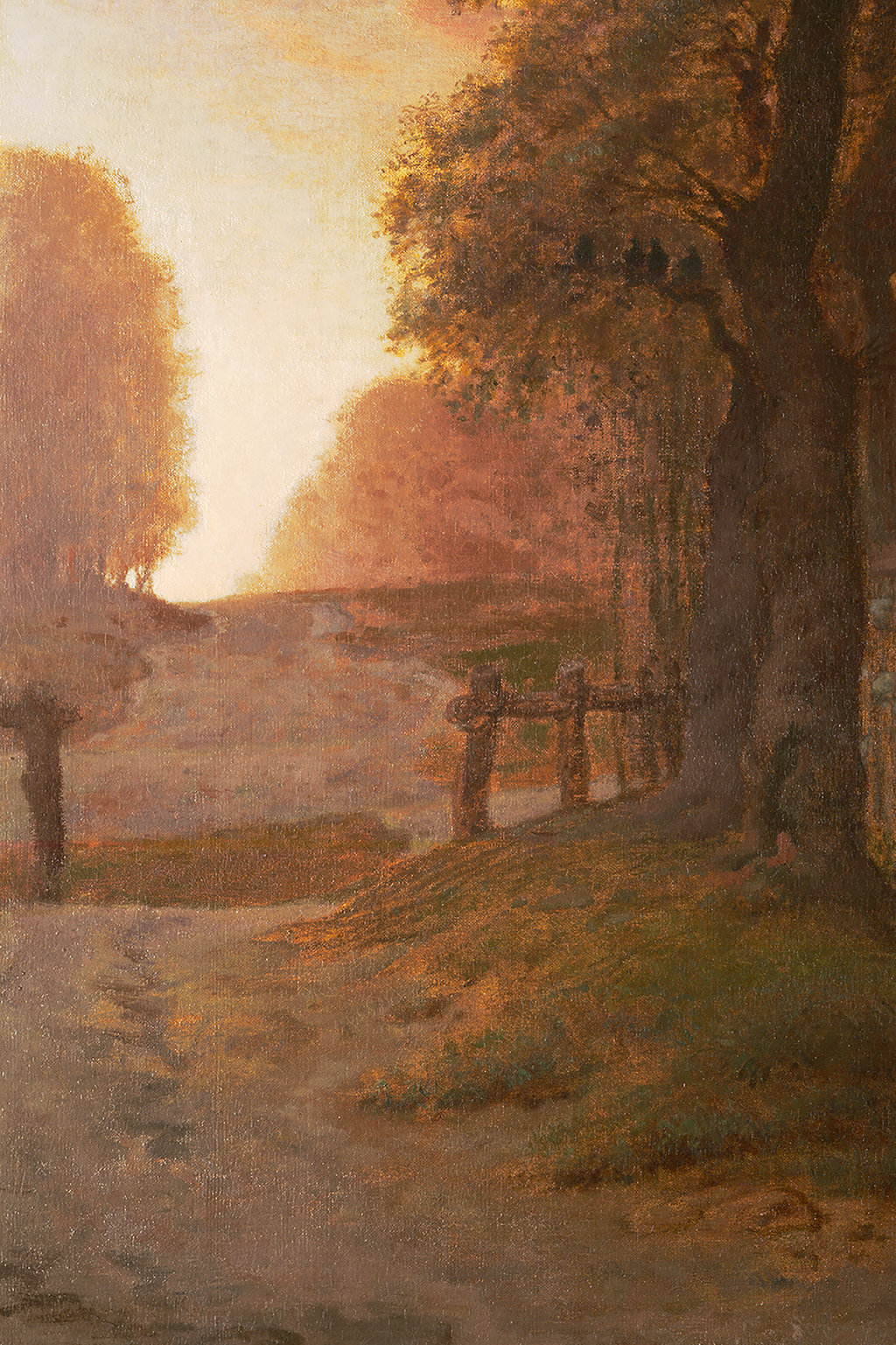 Fig. 7. Detail of Waiting (ca. 1853–61), showing the use of the exposed reddish-brown wash to create the glow of the sunset filtering through the trees and reflected off the road
Fig. 7. Detail of Waiting (ca. 1853–61), showing the use of the exposed reddish-brown wash to create the glow of the sunset filtering through the trees and reflected off the road
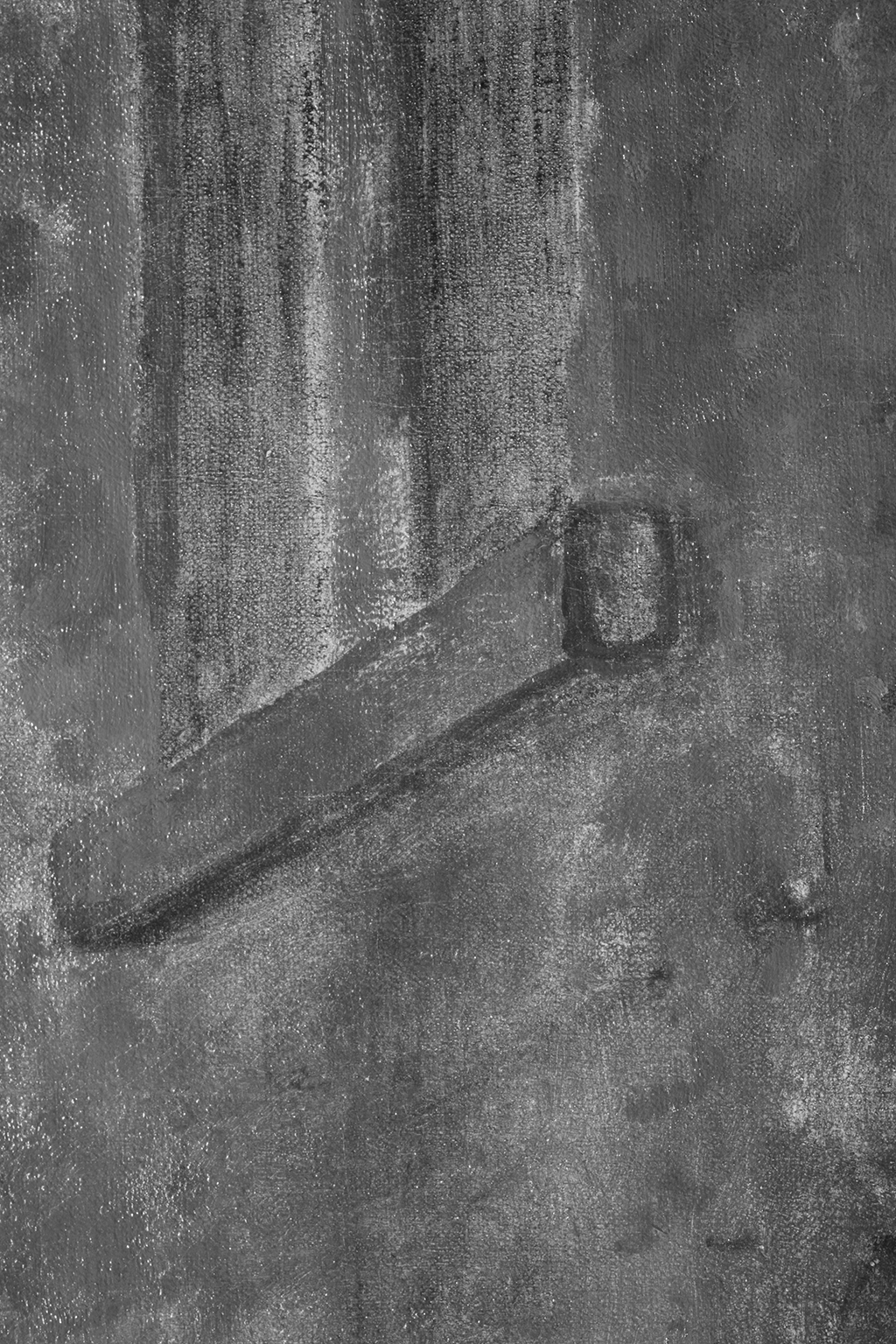 Fig. 8. Reflected infrared digital photograph of the window ledge, Waiting (ca. 1853–61)
Fig. 8. Reflected infrared digital photograph of the window ledge, Waiting (ca. 1853–61)
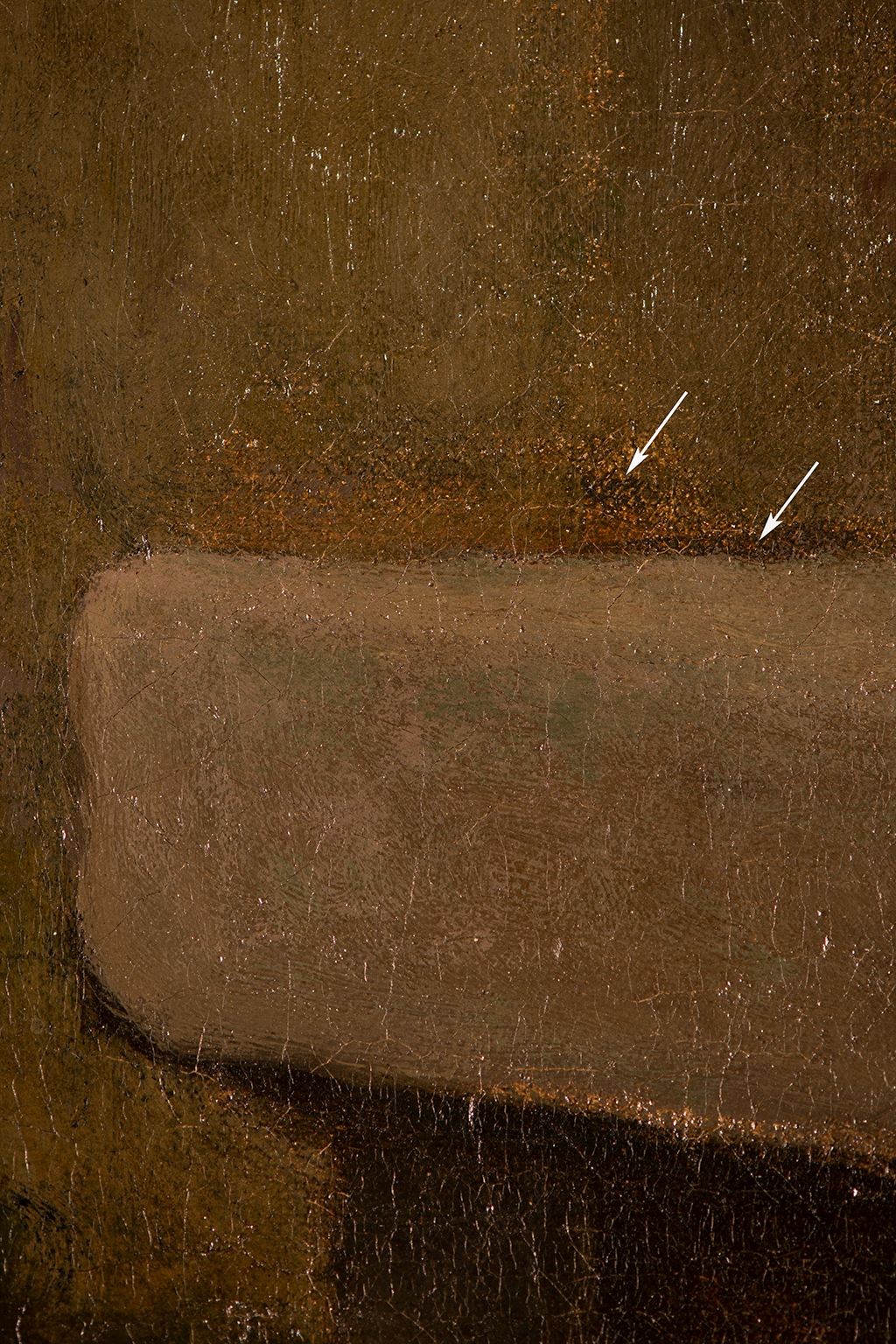 Fig. 9. Detail of the painted lines around the stone bench, Waiting (ca. 1853–61)
Fig. 9. Detail of the painted lines around the stone bench, Waiting (ca. 1853–61)
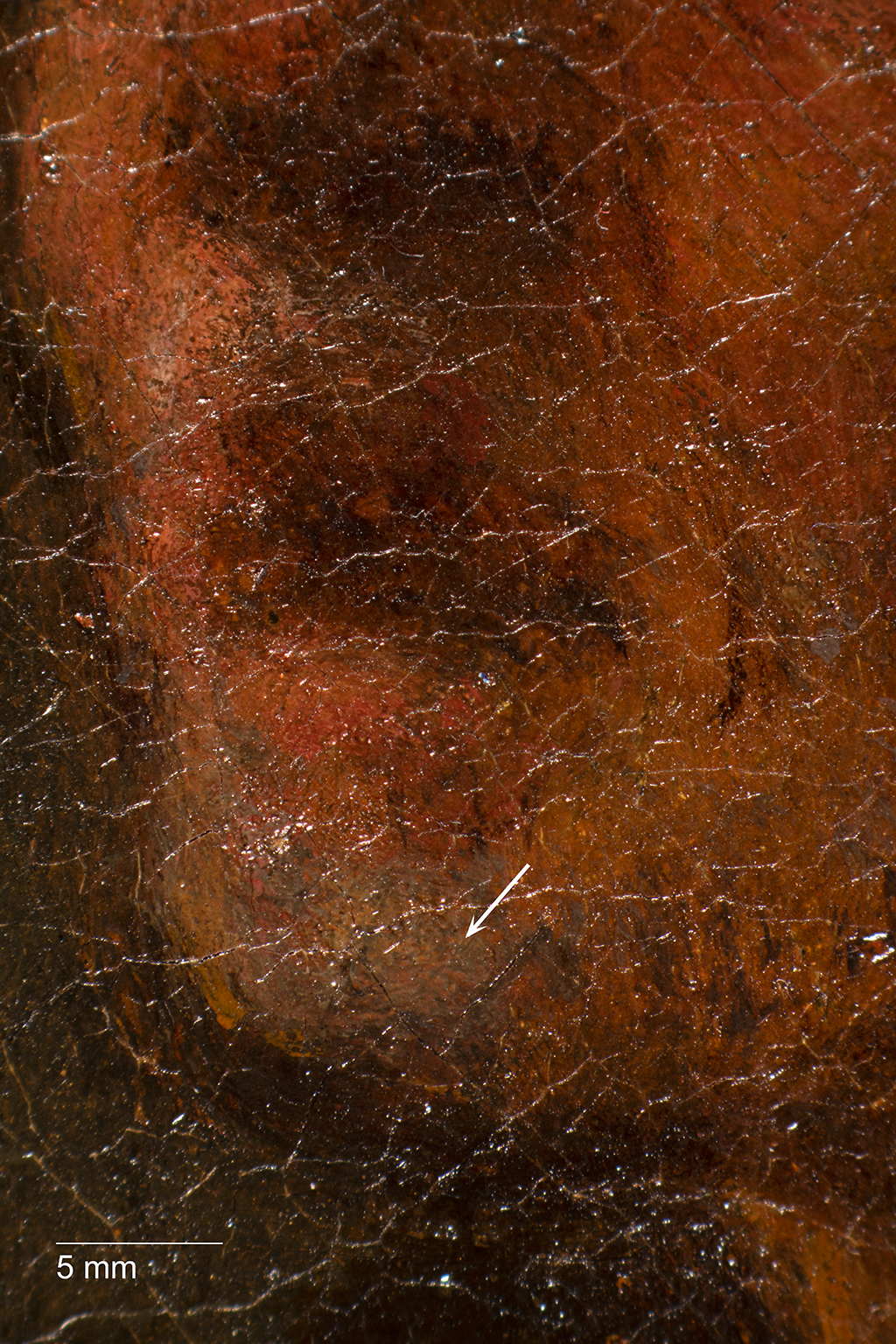 Fig. 10. Photomicrograph of underlying gray paint on Tobit’s face, Waiting (ca. 1853–61)
Fig. 10. Photomicrograph of underlying gray paint on Tobit’s face, Waiting (ca. 1853–61)
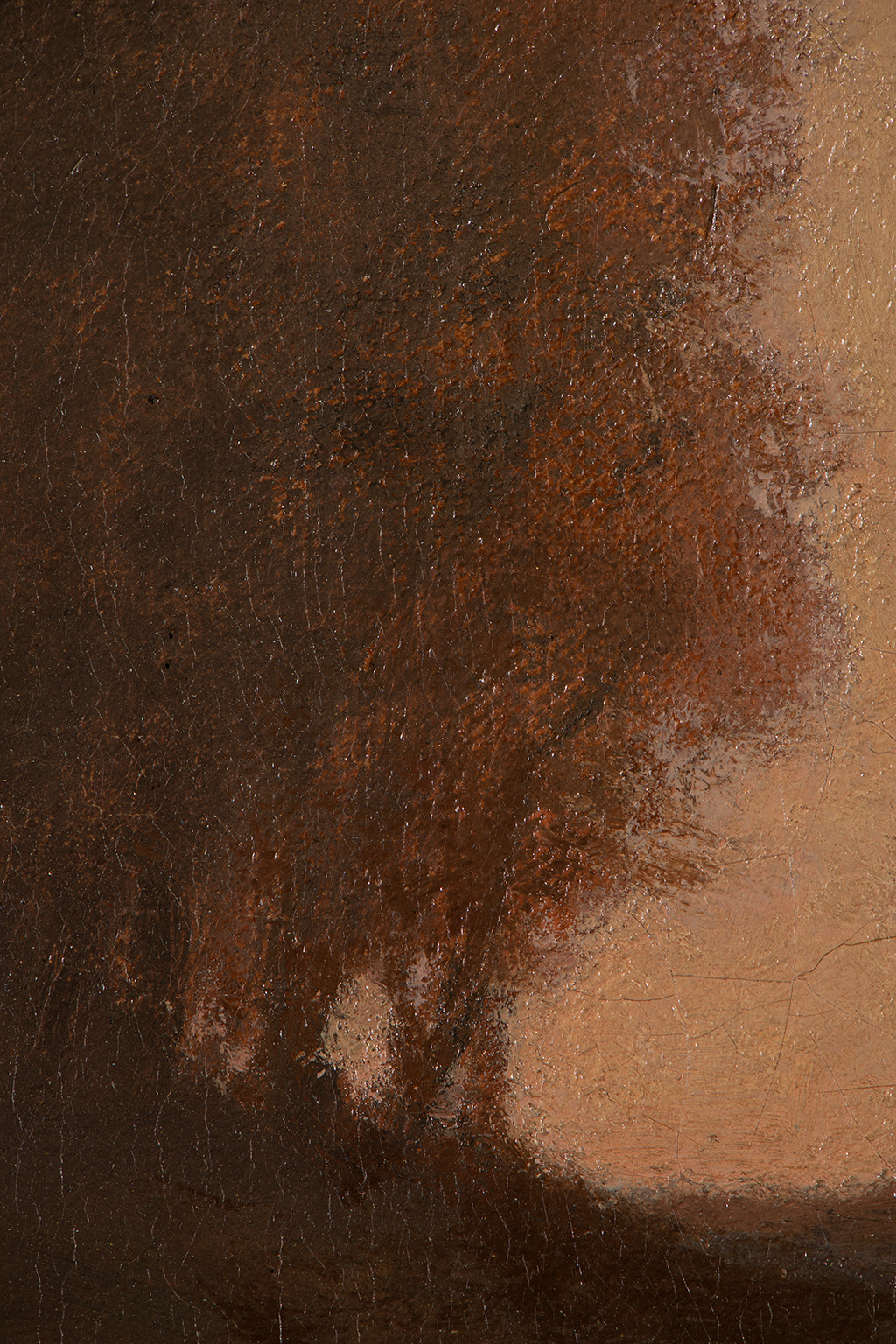 Fig. 11. Detail of the trees at upper left, Waiting (ca. 1853–61)
Fig. 11. Detail of the trees at upper left, Waiting (ca. 1853–61)
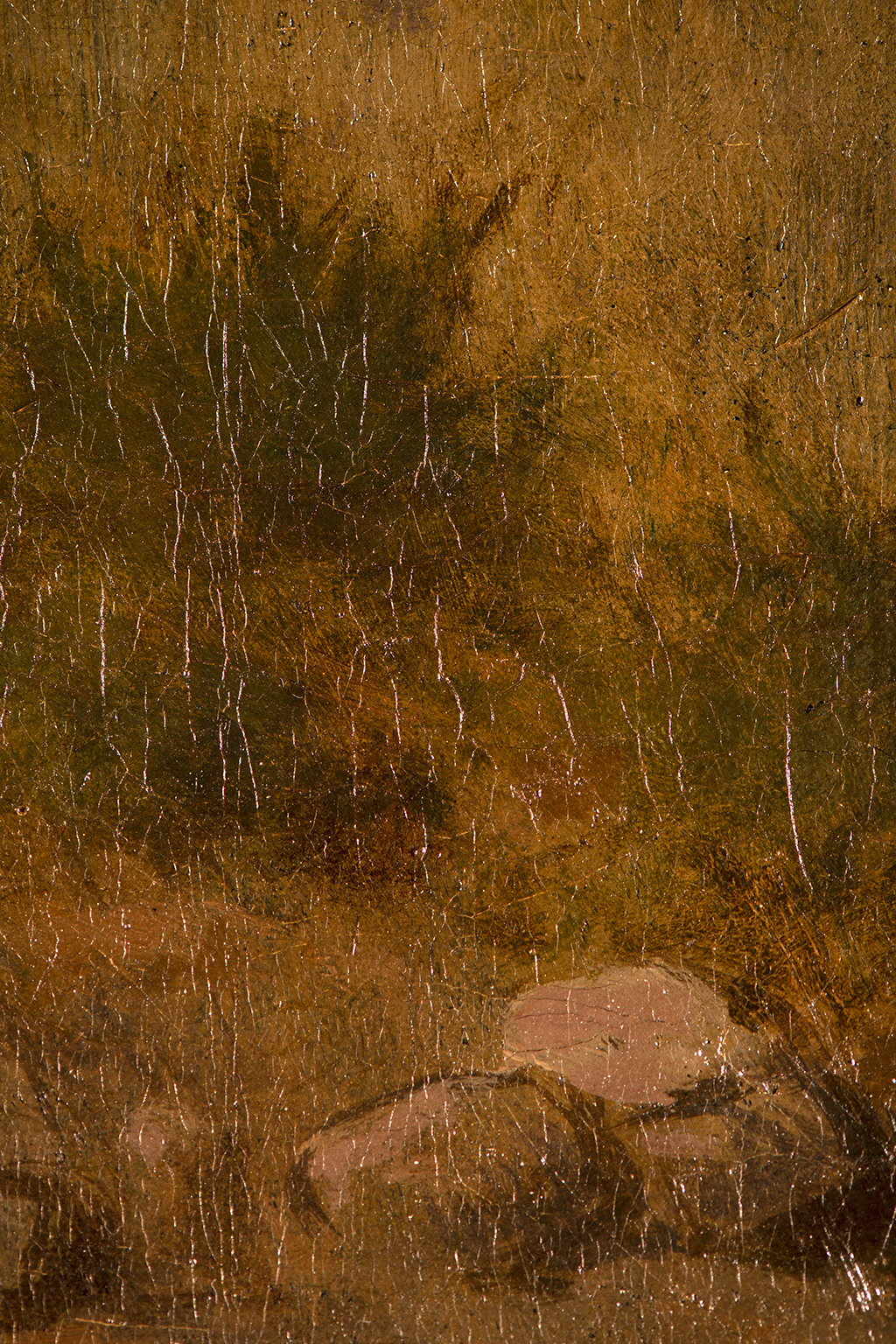 Fig. 12. Detail of the foreground, Waiting (ca. 1853–61)
Fig. 12. Detail of the foreground, Waiting (ca. 1853–61)
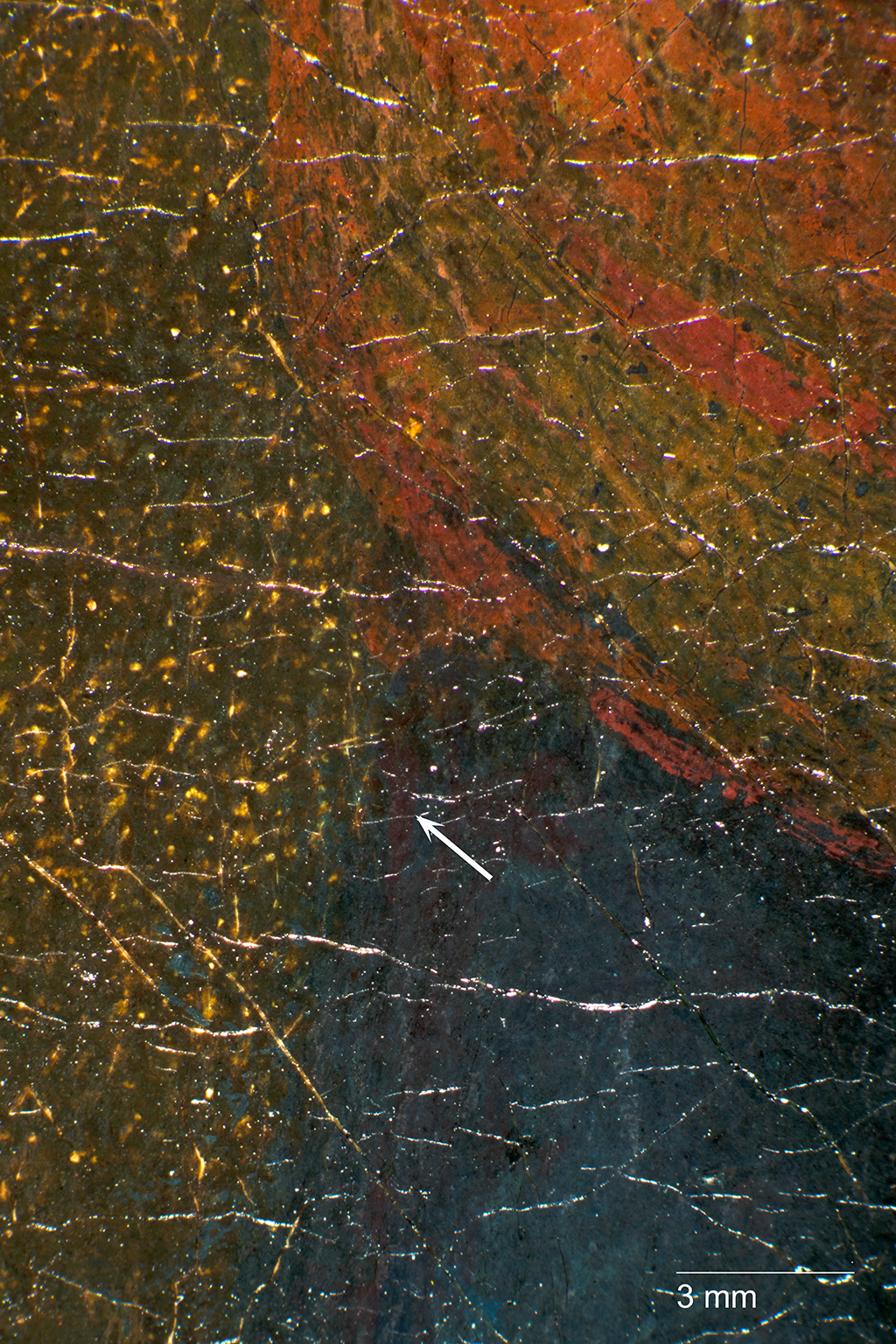 Fig. 13. Photomicrograph of Waiting (ca. 1853–61), showing the bright orange and pink outlines on Anna’s proper left hand and a transparent red-purple stroke at the edge of her skirt. The image is slightly overexposed to more easily view the faint red-purple paint.
Fig. 13. Photomicrograph of Waiting (ca. 1853–61), showing the bright orange and pink outlines on Anna’s proper left hand and a transparent red-purple stroke at the edge of her skirt. The image is slightly overexposed to more easily view the faint red-purple paint.
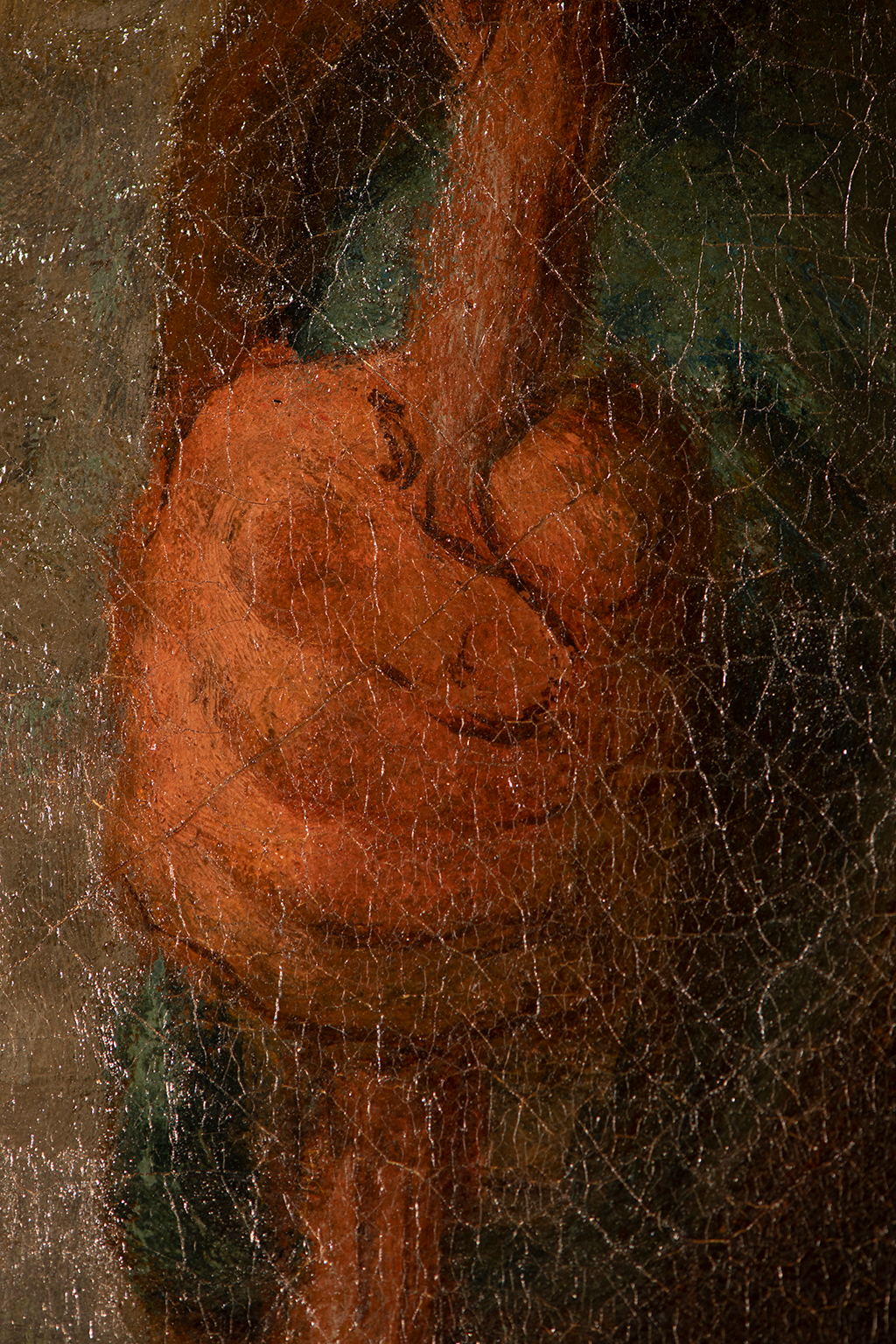 Fig. 14. Detail of the finely painted outlines on Tobit’s hand, Waiting (ca. 1853–61)
Fig. 14. Detail of the finely painted outlines on Tobit’s hand, Waiting (ca. 1853–61)
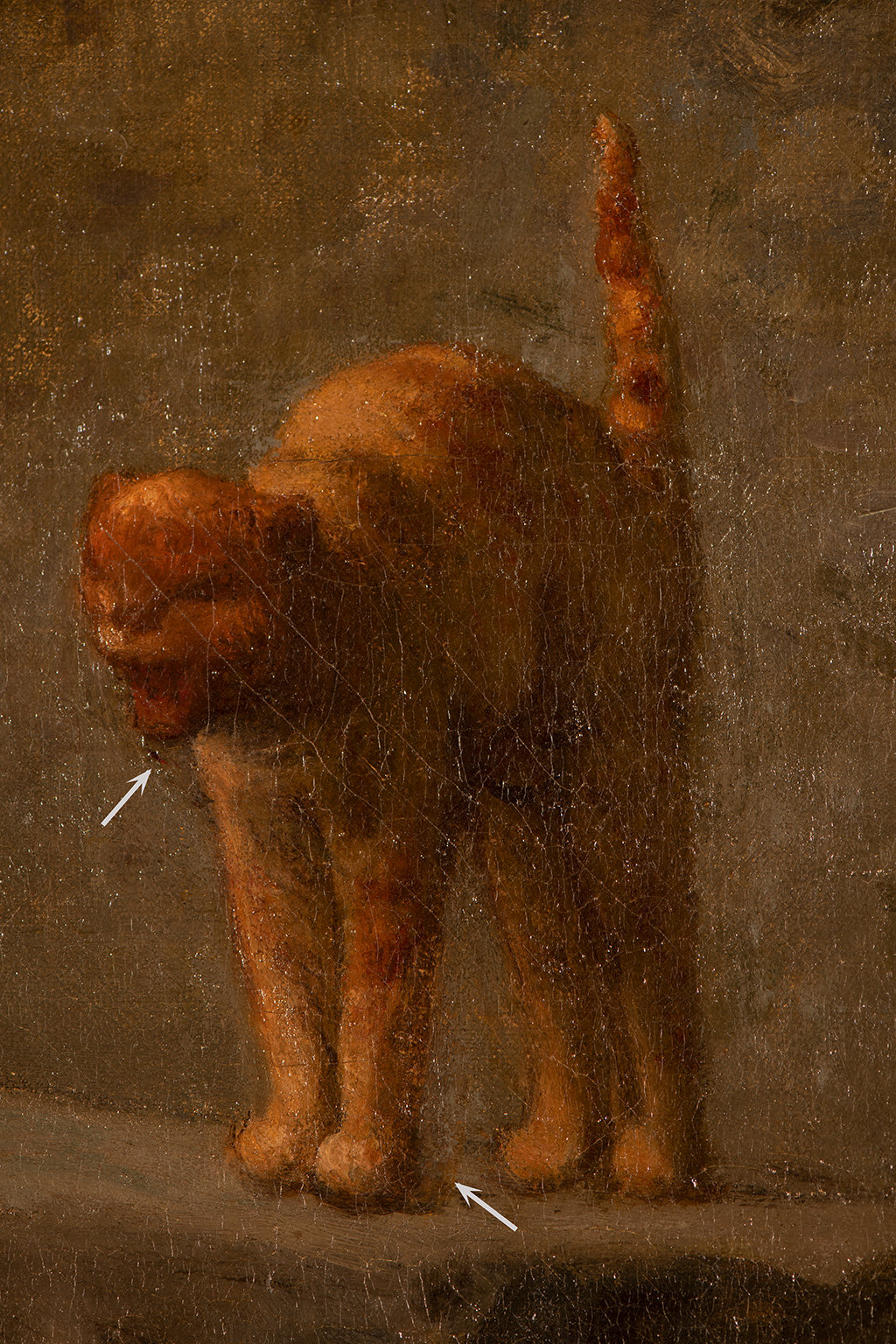 Fig. 15. Detail showing a slight repositioning of the cat’s head and legs, Waiting (ca. 1853–61)
Fig. 15. Detail showing a slight repositioning of the cat’s head and legs, Waiting (ca. 1853–61)
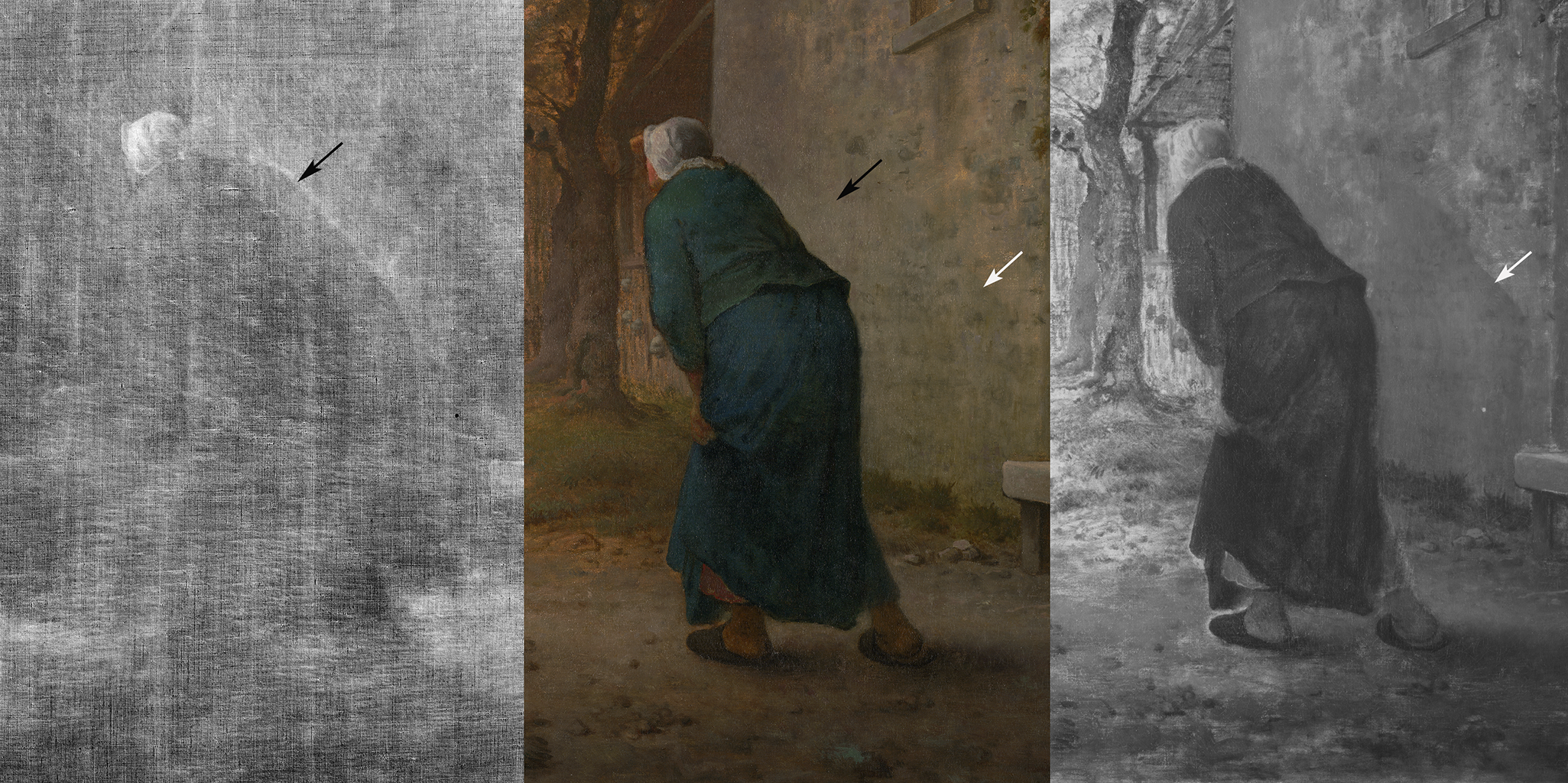 Fig. 16. Radiograph detail (left), normal illumination detail (center), and reflected infrared digital photograph detail (right) of Waiting (ca. 1853–61), revealing the two former positions of Anna. White arrows indicate the contours of the right silhouette, and black arrows mark the second silhouette.
Fig. 16. Radiograph detail (left), normal illumination detail (center), and reflected infrared digital photograph detail (right) of Waiting (ca. 1853–61), revealing the two former positions of Anna. White arrows indicate the contours of the right silhouette, and black arrows mark the second silhouette.
Notes
-
Creases and small fragments of the original turnover edgeturnover edge: The point at which the canvas begins to wrap around the stretcher, at the junction between the picture plane and tacking margin. See also foldover edge. are present on the lower right and upper left edges, and there appears to be a sliver of the turnover at the bottom edge (right side).
-
Millet frequently used standard-format canvases for his painting supports. See Stéphanie Constantin, “The Painters of the Barbizon Circle and Landscape Paintings: Techniques and Working Methods” (PhD Diss., Courtauld Institute of Art, 2001), 152.
-
David Bomford, Jo Kirby, John Leighton, and Ashok Roy, Art in the Making: Impressionism (London: Yale University Press, 1991), 45–46.
-
Constantin, “The Painters of the Barbizon Circle and Landscape Paintings,” 251.
-
The use of “crayon gras” here likely refers to a grease pencil or lithography crayon. For a discussion of the six categories of wax-based drawing media (colored pencil, grease pencil, lithographic crayon, wax crayon, oil pastel, and paint stick), see Margaret Holben Ellis and M. Brigitte Yeh, “The History, Use and Characteristics of Wax-based Drawing Media,” The Paper Conservator 22 (1998): 48–55.
-
Constantin, “The Painters of the Barbizon Circle and Landscape Paintings,” 226–28.
-
When the painting was studied under the stereomicroscope and with infrared reflectography, only two areas—vertical strokes within the window (center of the top edge) and the outer edges of the tallest tree—revealed potential drawn lines. This black material appears to lie on top of the ground where it is covered by the artist’s preliminary washes.
-
Constantin, “The Painters of the Barbizon Circle and Landscape Paintings,” 225–28.
-
Helmut Schweppe and John Winter, “Madder and Alizarin,” in Artists’ Pigments: A Handbook of Their History and Characteristics, ed. Elisabeth West FitzHugh (Washington, DC: National Gallery of Art, 1997) 3:124.
-
Ch[arles] Moreau-Vauthier, Comment on peint auhourd’hui (Paris: H. Floury, 1923), 31, cited in Constantin, “The Painters of the Barbizon Circle and Landscape Paintings,” 198.
-
Constantin, “The Painters of the Barbizon Circle and Landscape Painting,” 227.
-
See film-based radiographs, no. 438, Nelson-Atkins conservation file, 30-18.
-
When traction cracks, now covered by retouching, were studied under the stereomicroscope, underlying blue paint associated with Anna’s jacket and dress was visible. The repositioning of the figure is more readily apparent when these areas are viewed with the longer wavelength range of the Hamamatsu C1000-03 vidicon camera (1000–2200 nanometers).
-
There are no written reports or photographs associated with this early Nelson-Atkins treatment.
-
Mary Schafer, May 8, 2007, treatment report, Nelson-Atkins conservation file, 30-18.
Documentation
Citation
Chicago:
Danielle Hampton Cullen, “Jean-François Millet, Waiting, ca. 1853–61,” documentation in French Paintings and Pastels, 1600–1945: The Collections of The Nelson-Atkins Museum of Art, ed. Aimee Marcereau DeGalan (Kansas City: The Nelson-Atkins Museum of Art, 2022), https://doi.org/10.37764/78973.5.528.4033.
MLA:
Cullen, Danielle Hampton. “Jean-François Millet, Waiting, ca. 1853–61,” documentation. French Paintings and Pastels, 1600–1945: The Collections of The Nelson-Atkins Museum of Art, edited by Aimee Marcereau DeGalan, Nelson-Atkins Museum of Art, 2022. doi: 10.37764/78973.5.528.4033.
Provenance
Citation
Chicago:
Danielle Hampton Cullen, “Jean-François Millet, Waiting, ca. 1853–61,” documentation in French Paintings and Pastels, 1600–1945: The Collections of The Nelson-Atkins Museum of Art, ed. Aimee Marcereau DeGalan (Kansas City: The Nelson-Atkins Museum of Art, 2022), https://doi.org/10.37764/78973.5.528.4033.
MLA:
Cullen, Danielle Hampton. “Jean-François Millet, Waiting, ca. 1853–61,” documentation. French Paintings and Pastels, 1600–1945: The Collections of The Nelson-Atkins Museum of Art, edited by Aimee Marcereau DeGalan, Nelson-Atkins Museum of Art, 2022. doi: 10.37764/78973.5.528.4033.
Purchased from the artist by Arthur Stevens and Ennemond Blanc, Paris, by May 1, 1861 [1];
Henry Sayles (1834–1918), Boston, by 1878–at least May 1882;
George Ingraham Seney (1826–93), New York, by October 26, 1886–February 13, 1891;
Purchased at his sale, Mr. George I. Seney’s Important Collection of Modern Paintings, American Art Galleries, New York, February 13, 1891, lot 296, as Waiting, through Knoedler and Co., New York, by a private collector [2];
Jérôme Wheller, Chicago, by June 8, 1892 [3];
With Isidore Montaignac, Paris, by December 27, 1893 [4];
Purchased from Montaignac by Boussod, Valadon and Co., New York, stock books 13 and 14, no. 23270, as L’attente, December 27, 1893–December 22, 1894;
Purchased from Boussod, Valadon by Peter Arrell Brown Widener (1834–1915), Lynnewood Hall, Elkins Park, PA, December 22, 1894–November 6, 1915;
By descent to his son, Joseph Early Widener, Lynnewood Hall, Elkins Park, PA (1871–1943), 1915–at least 1921 [5];
With Arthur Joseph Sulley, London, by January 15, 1922 [6];
Half-share purchased from Sulley by Knoedler, New York, stock books 7 and 8, no. 15309, as L’Attente, January 15, 1922–May 1930 [7];
Purchased from Knoedler and Sulley by The Nelson-Atkins Museum of Art, Kansas City, MO, 1930.
Notes
[1] On March 14, 1860, Millet and Stevens signed a three-year contract, which stipulated that Millet would deliver his entire production of oil paintings and drawings to Stevens, in exchange for a fixed monthly stipend of 1000 francs. Included in the list of paintings to be given to Stevens “et Cie.” was Waiting. See “Le prix des œuvres de J.-F. Millet,” Le Temps 29, no. 10296 (July 14, 1889): unpaginated; and Étienne Moreau-Nélaton, Millet, Raconte par Lui-Même (Paris: Henri Laurens, 1921), 2:71–74. Stevens had entered into a partnership with the Parisian dealer Ennemond Blanc prior to the contract signing to reduce his risk; see T. H. Bartlett, “Barbizon and Jean-Francois Millet,” Scribner’s Magazine 7, no. 6 (June 1890): 742. It is not clear when Millet delivered Waiting to Stevens and Blanc, but he was still working on it in May 1860. At the latest, it was delivered in time for the Salon de 1861, which opened May 1.
[2] See letter from Edye Weissler, Librarian, Knoedler, to Simon Kelly and Meghan Gray, May 7, 2010, NAMA curatorial files. Weissler confirmed that Knoedler bid on behalf of a client at the Seney sale, but had no information about the identity of the client.
[3] The constituent’s name is also spelt variously as “Wheler” and “Wheeler”. We defer here to the spelling in the 1892 exhibition catalogue, Cent Chefs-d’œuvre des Écoles Françaises et Étrangères (Deuxième Exposition).
[4] Montaignac was a Paris representative for the American Art Association and a representative of the “Paris connoisseurs”. Montaignac may have owned the painting earlier. According to a journal article from December 1892, Montaignac bought the painting at the Seney Sale in 1891; see Montague Marks, “My Note-Book,” The Art Amateur (December 1892). It is not clear if Montaignac had a working relationship with Knoedler or Wheller, or if he was acting separately. The Boussod, Valadon and Co. stock books indicate that Montaignac received a percentage of the bénéfice (profit) from their sale of the painting to Widener. See Getty Research Institute, Los Angeles, Goupil et Cie / Boussod, Valadon and Co. Records, Series II: Boussod, Valadon and Co. Stock Books (1875–1919), Livre no. 13 (1891–1895), p. 159, row 14, no. 23270; and Livre no. 14 (1895–1901), p. 46, row 3, no. 23270.
Charles Tyson Yerkes (1837–1905), Chicago, was also credited as a possible owner of the painting after the Seney sale; see Montague Marks, “My Note-Book,” The Art Amateur 36, no. 105 (May 1897). Yerkes was a prominent Chicago art collector, and much of his art collection was well documented and catalogued. The painting is not included in his 1893 Catalogue from Collection of Charles T. Yerkes. Additionally, Marks also notes that many collectors were falsely credited with ownership of this painting. See Montague Marks, “My Note Book,” The Art Amateur 4, no. 30 (March 1894): 98.
[5] Widener’s eldest son, George Dunton Widener, died aboard the Titanic on April 15, 1912, so his second son inherited his art collection; see “Widener’s Estate Intact for 70 Years,” The New York Times 65, no. 21, 222 (November 23, 1915): 1. Waiting still belonged to Joseph Early Widener as late as 1921; see Étienne Moreau-Nélaton, Millet, Raconte par Lui-Même (Paris: Henri Laurens, 1921), 2:194.
[6] Sulley (1853–1930) was an art dealer and Widener’s London agent.
[7] On January 15, 1922, Knoedler paid Sulley £14,000 for joint ownership of fourteen paintings from the Widener collection, including Waiting. See Getty Research Institute, Los Angeles, M. Knoedler and Co. Records, Series I.A. (Painting, 1872–1970), Box 7, Painting stock book 7 (nos. 15140–17039, January 1921–December 1927), p. 27, row 9, no. 15309. It remained in their joint possession until May 1930, when it was acquired by The Nelson-Atkins Museum of Art; see Getty Research Institute, Los Angeles, M. Knoedler and Co. Records, Series I.A. (Painting, 1872–1970), Box 8, Painting stock book 8 (nos. A1–A2680, January 1928–November 1943), p. 6, row 45, no. 15309. The work was formally acquisitioned by the Nelson-Atkins on June 21, 1930.
Preparatory Works
Citation
Chicago:
Danielle Hampton Cullen, “Jean-François Millet, Waiting, ca. 1853–61,” documentation in French Paintings and Pastels, 1600–1945: The Collections of The Nelson-Atkins Museum of Art, ed. Aimee Marcereau DeGalan (Kansas City: The Nelson-Atkins Museum of Art, 2022), https://doi.org/10.37764/78973.5.528.4033.
MLA:
Cullen, Danielle Hampton. “Jean-François Millet, Waiting, ca. 1853–61,” documentation. French Paintings and Pastels, 1600–1945: The Collections of The Nelson-Atkins Museum of Art, edited by Aimee Marcereau DeGalan, Nelson-Atkins Museum of Art, 2022. doi: 10.37764/78973.5.528.4033.
Jean-François Millet, The Parents of Tobias Awaiting His Return (L’Attente) (recto and verso), ca. 1853–54, charcoal and pastel on blue-gray paper, 10 5/8 x 12 in. (27 x 30.5 cm), Santa Barbara Museum of Art, California. Gift of Dr. and Mrs. Edward L. Tuohy, 1959.31.
Jean-François Millet, The Prodigal Son, 1856, charcoal on gray-blue stained paper, 27 7/3 x 18 57/64 in. (61.5 x 48 cm), Musée du Louvre, Paris.
Jean-François Millet, Figure Coming Out of a Wood (verso), nineteenth century, pencil on paper, 4 3/4 x 6 1/8 in. (12.2 x 15.5 cm), Musée du Louvre, Paris.
Jean-François Millet, Study for Tobit or Waiting from 1861, nineteenth century, pencil on paper, 2 1/2 x 4 3/4 in. (6.5 x 12.1 cm), Musée du Louvre, Paris.
Jean-François Millet, Study for Tobit or Waiting, nineteenth century, pencil on paper, 3 1/8 x 3 5/8 in. (8.1 x 9.2 cm), Musée du Louvre, Paris.
Jean-François Millet, Study for Tobit or Waiting (recto), nineteenth century, pencil on paper, 3 3/8 x 4 1/4 in. (8.6 x 10.8 cm), Musée du Louvre, Paris.
Jean-François Millet, Half-figure of Tobit, for Tobit or Waiting (verso), nineteenth century, pencil on paper, 3 3/8 x 4 1/4 in. (8.6 x 10.8 cm), Musée du Louvre, Paris.
Jean-François Millet, Study for Tobit or Waiting, nineteenth century, pencil on paper, 2 3/8 x 2 3/8 in. (5.9 x 5.6 cm), Musée du Louvre, Paris.
Jean-François Millet, Study for Tobit or Waiting, nineteenth century, pencil on paper, 5 x 4 in. (12.2 x 9.7 cm), Musée du Louvre, Paris.
Jean-François Millet, Sketch for Tobit or Waiting, nineteenth century, pencil on paper, 7 x 4 5/8 in. (16.9 x 11.7 cm), Musée du Louvre, Paris.
Jean-François Millet, Peasant woman seen from behind, for Tobit or Waiting, nineteenth century, pencil on paper, 9 1/2 x 5 5/8 in. (24.2 x 14.4 cm), Musée du Louvre, Paris.
Jean-François Millet, An Old Woman, in profile to the left, Looking through a Window, nineteenth century, pencil on paper, 6 x 4 in. (15.4 x 10.3 cm), Musée du Louvre, Paris.
Jean-François Millet, Two Figures on the Landing of a House, nineteenth century, pencil on paper, 2 1/2 x 5 in. (6.5 x 12.7 cm), Musée du Louvre, Paris.
Jean-François Millet, Woman Standing, Seen from Behind (verso), ca. 1860, black conté crayon on paper, 12 9/16 x 10 3/16 in. (31.9 x 25.8 cm), Musée du Louvre, Paris.
Jean-François Millet, Study of Hands (recto), ca. 1860, black conté crayon on paper, 12 9/16 x 10 3/16 in. (31.9 x 25.8 cm) Musée du Louvre, Paris.
Jean-François Millet, Man in a Doorway; Standing Man; Leg (verso), nineteenth century, pencil on paper, 6 1/4 x 3 in. (15.8 x 10 cm), Musée du Louvre, Paris.
Jean-François Millet, Femme, vue de dos, balayant, devant une maison, nineteenth century, crayon on paper, 2 5/8 x 5 in. (6.7 x 12.5 cm), Musée du Louvre, Paris.
Jean-François Millet, Woman Standing, Seen from Behind, Looking into the Distance (recto), nineteenth century, pencil on paper, 2 5/8 x 4 in. (6.7 x 12.6 cm), Musée du Louvre.
Jean-François Millet, Alley of a Village (verso), nineteenth century, pencil on paper, 2 5/8 x 4 in. (6.7 x 12.6 cm), Musée du Louvre, Paris.
Exhibitions
Citation
Chicago:
Danielle Hampton Cullen, “Jean-François Millet, Waiting, ca. 1853–61,” documentation in French Paintings and Pastels, 1600–1945: The Collections of The Nelson-Atkins Museum of Art, ed. Aimee Marcereau DeGalan (Kansas City: The Nelson-Atkins Museum of Art, 2022), https://doi.org/10.37764/78973.5.528.4033.
MLA:
Cullen, Danielle Hampton. “Jean-François Millet, Waiting, ca. 1853–61,” documentation. French Paintings and Pastels, 1600–1945: The Collections of The Nelson-Atkins Museum of Art, edited by Aimee Marcereau DeGalan, Nelson-Atkins Museum of Art, 2022. doi: 10.37764/78973.5.528.4033.
Salon de 1861, Palais des Champs-Élysées, Paris, May 1–July 1, 1861, no. 2254, as L’attente.
Salon de la Société des Amis des Arts de Bordeaux, Galeries de la Société des Amis des Arts de Bordeaux, Bordeaux, March 20–May 18, 1869, no. 434, as L’attente.
An Exhibition of Contemporary Art Held Under the Direction of the Boston Art Club, the Boston Society of Architects, and the Schools of the Museum, also of the paintings shown by the Museum, Museum of Fine Arts, Boston, April 22–May 24, 1879, no. 118, as Tobit and Sara watching for the Return of Tobias.
Summer Loan Exhibition, Museum of Fine Arts, Boston, May 1882, no. 32, as Tobit and Anna looking for the Return of Tobias.
Exhibition of Oil Paintings at the Reception in Honor of the Representatives of the French Government Attending the Inauguration of the Statue of Liberty, Union League Club, New York, opened October 27, 1886, no. 64, as Waiting.
Mr. George I. Seney’s Collection of Paintings, Brooklyn Art Association, April 16–28, 1887, no. 45, as Waiting.
The works of Antoine-Louis Barye; also of Paintings by his contemporaries and Friends, The American Art Galleries, New York, November 1889, no. 573, as Waiting.
Cent Chefs-d’œuvre des Écoles Françaises et Étrangères (Deuxième Exposition), Galerie Georges Petit, Paris, June 8–July 29, 1892, no. 119, as L’Attente.
Exhibition of Nineteenth Century French Painters, Knoedler, London, June 26–July 21, 1923, no. 30, as Tobie ou L’Attente.
A Century of French Painting: Exhibition Organized for the Benefit of the French Hospital of New York, Knoedler, New York, November 12–December 8, 1928, no. 11, erroneously as Le Mendiant Aveugle.
Exhibition in conjunction with the Consumer Cooperative Association’s 30th Annual Meeting, Municipal Auditorium, Kansas City, MO, December 2–5, 1958.
Barbizon: First Anniversary Exhibition of Lakeview Center, Lakeview Center for the Arts and Sciences, Peoria, IL, April 6–May 16, 1966, unnumbered, as Waiting.
Raphael and America, National Gallery of Art, Washington, DC, January 9–May 8, 1983, no. 15, as L’Attente (Waiting).
Jean-François Millet, The Bunkamura Museum of Art, Tokyo, August 10–September 23, 1991; Kyoto Municipal Museum of Art, October 3–27, 1991; and Yamanashi Prefectural Museum of Art, November 3–December 8, 1991, no. 35, as Waiting.
Winslow Homer and the Critics: Forging a National Art in the 1870s, The Nelson-Atkins Museum of Art, Kansas City, MO, February 18–May 6, 2001; Los Angeles County Museum of Art, June 10–September 9, 2001; High Museum of Art, Atlanta, October 6, 2001–January 6, 2002, (Kansas City only), hors cat., as Waiting.
Amitié et amour à travers l’œuvre de Millet, The Yamanasi Prefectural Museum of Art, Kofu, Japan, July 19–August 31, 2014; Fuchu Art Museum, Fuchu, Japan, September 10–October 23, 2014; The Miyagi Museum of Art, Sendai, Japan, November 1–December 14, 2014, no. 40, as L’attente (Tobie et sa femme).
Jean-François Millet: Sowing the Seeds of Modern Art, Van Gogh Museum, Amsterdam, October 4, 2019–January 12, 2020; Millet and Modern Art: From Van Gogh to Dalí, Saint Louis Art Museum, February 16–September 7, 2020.
References
Citation
Chicago:
Danielle Hampton Cullen, “Jean-François Millet, Waiting, ca. 1853–61,” documentation in French Paintings and Pastels, 1600–1945: The Collections of The Nelson-Atkins Museum of Art, ed. Aimee Marcereau DeGalan (Kansas City: The Nelson-Atkins Museum of Art, 2022), https://doi.org/10.37764/78973.5.528.4033.
MLA:
Cullen, Danielle Hampton. “Jean-François Millet, Waiting, ca. 1853–61,” documentation. French Paintings and Pastels, 1600–1945: The Collections of The Nelson-Atkins Museum of Art, edited by Aimee Marcereau DeGalan, Nelson-Atkins Museum of Art, 2022. doi: 10.37764/78973.5.528.4033.
Explication des Ouvrages de Peinture, Sculpture, Gravure, Lithographie et Architecture des Artistes Vivants, Exposés au Palais des Champs-Élysées le 1er Mai 1861, exh. cat. (Paris: Charles de Mourgues Frères, 1861), 271, as L’attente [repr., in H. W. Janson, ed., Catalogues of the Paris Salon: 1673–1881, vol. 42, Paris Salon de 1861 (New York: Garland, 1977), 271].
Paul de Saint-Victor, “Salon de 1861,” La Presse 26 (March 25, 1861): unpaginated, as L’Attente.
François Beslay, “Salon de 1861,” Revue d’économie chrétienne: consacrée à l’étude des intérêts 2 (May/June 1861): 496, as Retour de Tobie.
Anatole de la Forge, “L’Art Contemporain: Salon de 1861,” Le Siècle, no. 9514 (May 2, 1861): unpaginated, as L’Attente.
Louis Leroy, “Salon de 1861,” Le Charivari 30 (May 15, 1861): unpaginated, as L’Attente.
Théophile Thoré [William Bürger], “Salon de 1861,” Le Temps, no. 22, (May 17, 1861): unpaginated, as l’Attente.
Claudius Lavergne, “Beaux-Arts: Exposition de 1861,” Le Monde, no. 139 (May 23, 1861): unpaginated, as l’attente.
Augustin Joseph du Pays, “Salon de 1861,” L’Illustration 38, no. 952 (May 25, 1861): 330.
Alphonse de Calonne, “La Peinture contemporaine à l’exposition de 1861,” Revue Contemporaine 21, no. 56 (May 31, 1861): 342–43.
Théodore Pelloquet, “Salon de 1861,” Le Courrier du Dimanche (June 2, 1861): 5.
Jean Rousseau, “Salon de 1861: Discutés,” Le Figaro, no. 658 (June 6, 1861): 6, as L’Attente.
Henri Page, “Salon de 1861,” Le Tintamarre (June 9, 1861): 3, as Tobie.
Albert de la Fizelière, “Salon de 1861,” Revue Anecdotique des Excentricités Contemporaines 3, no. 12 (June 15, 1861): 270–71, as L’Attente.
William Bürger [Théophile Thoré], “Salon de 1861,” L’independence belge (June 17, 1861): unpaginated.
“Nadar Jury au Salon de 1861,” Journal Amusant, no. 286 (June 22, 1861): 1, as La Mère de Tobie Guettant le Retour de son Fils.
Théodore Pelloquet, “Salon de 1861,” Le Monde Illustré 8, no. 219 (June 22, 1861): 391, as Tobie.
Richard Cortambert, “Promenade d’un fantaisiste à l’exposition de beaux-arts,” Revue Du Monde Colonial 5, no. 12 (June 25, 1861): 701–702.
Léon Lagrange, “Salon de 1861,” Gazette des Beaux-Arts, no. 61 (July 1, 1861): 63, as L’Attente.
Edmond Jacques, “Salon de 1861,” l’univers illustré 4, no. 164 (July 4, 1861): 246.
Théophile Gautier, “Salon de 1861,” Le Moniteur Universel, no. 107 (July 6, 1861) : unpaginated, as L’attente.
Louis Brès, “Salon de 1861,” Moniteur des Arts 4, no. 183 (July 13, 1861): unpaginated, as L’Attente.
Jean Rousseau, “Salon de 1861,” Le Voleur 34, no. 246 (July 19, 1861): 186, as L’Attente.
Comtesse de Rethel, “Exposition de peinture de 1861,” Journal des Dames et des Demoiselles 17, no. 12 (September 1861): 191.
Emile Perrin, “Salon de 1861,” Revue Européenne 16 (1861): 169, as l’Attente.
Maxime du Camp, Salon de 1861 (Paris: A. Bourdilliat, 1861), 112, as L’Attente.
A. Cantaloube, Lettre sur les expositions et le Salon de 1861 (Paris: E. Dentu, 1861), 96, as Tobie.
Jane d’Enval, Salon de 1861 (Paris, 1861), 54–55, as L’Attente.
Albert de la Fizelière, A–Z ou le Salon en miniature (Paris: Poulet-Malassis et de Broise, 1861), 39, as l’Attente.
Théophile Gautier, L’Abécédaire du Salon de 1861 (Paris: E. Dentu, 1861), 285–86, as l’Attente.
Olivier Merson, Exposition de 1861: La Peinture en France (Paris: E. Dentu, 1861), 221–22, as L’Attente.
Ednah Dow Cheney, “Jean-François Millet,” The Radical (July 1867): unpaginated.
Explication des Ouvrages de Peinture, Sculpture, Architecture, Gravure et Lithographie des Artistes Vivants, exh. cat. (Bordeaux: Imprimeur de la Société, 1869), 53, as L’attente.
T.[héophile] Thoré, Salons de W. Bürger, 1861 à 1868 (Paris: Jules Renouard, 1870), 1:35, 97–98, as Tobie et sa femme and l’Attente.
“A Great Artist Gone,” Old and New 11, no. 4 (April 1875): 495, as Blind Tobias.
Alexandre Piedagnel, J.-F. Millet: Souvenirs de Barbizon (Paris: A. Cadart, 1876), 62, 69, as L’Attente.
Philippe Burty, Maitres et Petits Maitres (Paris: G. Charpentier, 1877), 293, as Famille de Tobie.
Eleventh Catalogue of the Collection of Ancient and Modern Works of Art Given or Lent to the Trustees (Boston: Alfred Mudge and Sons, 1878), 99, Tobit and Sara watching for the Return of Tobias.
Edward Strahan, Art Treasures of America, Being the Choicest Works of Art in the Public and Private Collections of North America (Philadelphia: George Barrie, 1879), 93–94, as Tobit.
Trustees of the Museum of Fine Arts Third Annual Report (Boston: Alfred Mudge and Son, 1879), 17.
Catalogue of an Exhibition of Contemporary Art Held Under the Direction of the Boston Art Club, the Boston Society of Architects, and the Schools of the Museum, Also of the Paintings Shown by the Museum, exh. cat. (Boston: Alfred Mudge and Sons, 1879), 9, as Tobit and Sara watching for the Return of Tobias.
Alfred Sensier and Helena De Kay, Jean-François Millet, Peasant and Painter (Boston: J. R. Osgood, 1881), 99, 119, 144, as Waiting.
Greta, “Boston Correspondence,” The Art Amateur 4, no. 3 (February 1881): 51, as Tobias and Anna.
Alfred Sensier, La Vie et l’Œuvre de J.-F. Millet (Paris: A. Quantin, 1881), 137, 161, 166, 205–06, 215–17, as l’Attente.
Catalogue of Works of Art Exhibited, exh. cat. (Boston: Alfred Mudge and Sons, 1882), 5, as Tobit and Anna watching for the Return of Tobias.
“Art Notes,” The Art Journal (1882): 317, as Tobit and Anna looking for the Return of Tobias.
Jules Claretie, Peintres and sculpteurs contemporains; portraits gravés par L. Massard (Paris: Librairie des Bibliophiles, 1882), 91n1, as L’Attente.
Trustees of the Museum of Fine Arts Sixth Annual Report (Boston: Alfred Mudge and Sons, 1882), 27.
Charles Yriarte, J.-F. Millet (Paris: Jules Rouam, 1885), 26, 28, as Tobie.
Exhibition of Oil Paintings at the Reception in Honor of the Representatives of the French Government Attending the Inauguration of the Statue of Liberty, exh. cat. (New York: Union League Club, 1886), 18, as Waiting.
“Art Notes,” The Critic 149 (November 6, 1886): 223, as Waiting.
Catalogue of Mr. George I. Seney’s Collection of Paintings, exh. cat. (New York: Rogers and Sherwood, 1887), 7, as Waiting.
“Loan of Mr. Seney’s Pictures,” New York Times 36, no. 11,116 (April 18, 1887): 4, as Waiting.
“Art Notes,” The Critic 173 (April 23, 1887): 210, as Waiting.
Olivier Merson, “Exposition des œuvres de J.-F. Millet à l’Ecole des Beaux-Arts,” Le Monde Illustre 31, no. 1573 (May 21, 1887): 330, as l’Attente.
“The New Seney Collection,” The Art Amateur 17, no. 1 (June 1887): 10, as Waiting.
E. Durand Gréville, “La Peinture aux états-unis: Les galleries privées,” Gazette des beaux-arts 36 (July 1887): 75, as Tobie.
Julia Ady, “Jean-Francois Millet,” Littell’s Living Age 179, no 2312 (October 20, 1888): 164.
C[lara Cornelia] H[arrison] Stranahan, A History of French Painting from Its Earliest to Its Latest Practice, Including an Account of the French Academy of Painting (New York: Charles Scribner’s Sons, 1888), 375, as The Waiting and Tobit.
Montezuma, “The Note Book,” The Art Amateur 21, no. 6 (November 1889): 114, as The Blind Tobias and His Wife awaiting the Return of Their Son.
Catalogue of the works of Antoine-Louis Barye; also of paintings by his contemporaries and Friends, exh. cat. (New York: Press of J. J. Little, 1889), 81, as Waiting.
“The Barye Monument Fund Exhibition,” The Art Amateur 22, no. 1 (December 1, 1889): 4.
Susan Hayes Ward, “Fine arts: The Barye Exhibition,” The Independent 41, no. 2141 (December 12, 1889): 9, as Waiting.
Alfred Trumble, The Painter of “The Angelus”: A Study of the Life, Labors, and Vicissitudes of Jean François Millet (New York: American Art Association, 1889), 37, as Waiting.
“The Barye Monument Fund Exhibition,” The Art Amateur 22, no. 2 (January 1, 1890): 31–32, as Waiting.
“The Barye Exhibition,” The American Architect and Building News 27, no. 732 (January 4, 1890): 12, as Waiting.
“The Barye Memorial Exhibition,” The Art Amateur 22, no. 4 (March 1890): 74.
J. M. Hoppin, “Some Criticisms on French Landscape-painting, Suggested by the Recent Exhibition in New York,” New Englander and Yale Review 16, no. 241 (April 1890): 314, as Blind Tobias.
T. H. Bartlett, “Barbizon and Jean-Francois Millet,” Scribner’s Magazine 7, no. 6 (June 1890): 743, as Tobit.
John W. Mollett, The Painters of Barbizon: Millet, Rousseau, Diaz, Corot, Daubigny, Dupré (London: Sampson Low, Marston, Searle and Rivington, 1890), 115–16, as Expectation (L’Attente) and Tobias.
David Croal Thomson, The Barbizon School of Painters: Corot, Rousseau, Diaz, Millet, Daubigny, Etc. (London: Chapman and Hall, 1890), x, 232, 235, as Waiting: Tobit.
“The Seney Paintings,” Illustrated American 5, no. 50 (January 31, 1891), 452, 457, 461, 464, (repro.), as Waiting, or Blind Tobias.
Susan Hayes Ward, “Fine Arts: Mr. George I. Seney’s Collection of Modern Paintings,” The Independent 43 (February 12, 1891): 9, as Waiting (Tobias).
“The Seney Sale is Ended: Very Large Prices Realized on Yesterday’s Sales; Millet’s ‘Waiting’ Fetches the Highest Figure of the Lot after Spirited Bidding; Mr. Seney Gratified at the Results,” New York Time 40, no. 12,315 (February 14, 1891): 5, as Waiting.
“The Fine Arts,” The Critic 15 (February 21, 1891): 101, as Waiting.
“Vente G.-I. Seney à New-York,” La Chronique des arts et de la curiosité (February 21, 1891): unpaginated, as L’Attente.
Catalogue of Mr. George I. Seney’s Important Collection of Modern Paintings (New York: American Art Association, 1891), 92, 286, as Waiting.
Frédéric Jacque, Le Livre d’or de J.-F. Millet par un ancien ami (Paris: Georges Chamerot, 1891), 79, 106, 109, 110–11, 113–14, 147, as l’Attente.
Cent Chefs-d’œuvre des Écoles Françaises et Étrangères (Deuxième Exposition), exh. cat. (Paris: Galerie Georges Petit, 1892), 125, as L’Attente.
Cousin Pons, “Les Cent Chefs-d’Œuvre,” Le Figaro 38, no. 156 (June 4, 1892): unpaginated, as L’attente.
“Les Cent Chefs-d’Oeuvre,” Le Matin 9, no. 3020 (June 6, 1892): unpaginated, as L’Attente.
“Les Cent Chefs-d’Oeuvre,” Le Matin 9, no. 3024 (June 10, 1892): 2, as L’Attente.
Raoul Sertat, “Beaux-Arts: Expositions à Paris,” Revue Encyclopédique (1892): 1110, as L’Attente.
George Lafenestre and Léon Roger-Milès, Cents Chefs-d’Œuvre des Collections Françaises et Étrangères (Paris: G. Petit, 1892), 24, 164, (repro.), as L’Attente.
Catalogue de dessins, tableaux et esquisses par J. F. Millet, exh. cat. (Paris: Hotel Drouot, 1894), 5, as L’Attente.
Montague Marks, “My Note Book,” The Art Amateur 4, no. 30 (March 1894): 98, as Waiting.
L. Roger-Milès, Le paysan dans l’ɶuvre de J. F. Millet (Paris: G. Petit, 1895), 13, (repro.), as L’attente de Tobie and l’attente.
Julia [Mary] Cartwright [Ady], Jean-François Millet: His Life and Letters (London: Swan Sonnenschein, 1896), 122, 141, 206–07, 211–13, as L’Attente and Tobit and his Wife awaiting the Return of their Son.
Montague Marks, “My Note Book,” The Art Amateur 36, no. 5 (May 1897): 105, as Waiting.
Henri Petitjean, “Le Modèle de Millet” Le Figaro 44 no. 270 (September 27, 1898): 3, as L’Attente.
“Here and There,” New York Times: Saturday Review (November 5, 1898): 742, as L’Attente.
Henry Naegely, J. F. Millet and Rustic Art (London: Elliot Stock, 1898), 124, as Awaiting.
Netta Peacock, “Millet’s Model,” The Artist 25, no. 235 (August 1899): 132–33, as L’Attente.
Probably “The Works of Millet: The Principal Paintings of Millet with Their Present Locations,” Masters in Art 1, pt. 8 (August 1900): 35, as Tobit or Tobias.
Catalogue of Paintings Forming the Private Collection of P. A. B. Widener, Ashbourne, Near Philadelphia: Part 1, Modern Paintings ([Paris]: [Goupil], 1900), 82, (repro.), as L’Attente.
Estelle M. Hurll, Jean François Millet: A Collection of Fifteen Pictures and a Portrait of the Painter (Cambridge: Riverside Press, 1900), 17, as Waiting.
Romain Rolland, Millet (London: Duckworth, 1902), 24, 97, as Tobias and his Wife waiting, in the hope of their son’s return and Waiting.
N. Hudson Moore, “The United States as an Art Center,” The Chautauquan: A Weekly Newsmagazine 36, no. 4 (January 1903): 427, as Tobias.
Edgcumbe Staley, “Jean Francois Millet, of Barbizon, as a Draughtsman,” The Printseller and Collector 1, no. 10 (October 1903): 421, as L’Attente.
Edgcumbe Staley, Jean-François Millet (London: G. Bell and Sons, 1903), 21, 67, as L’attente.
Michael Bryan and George Charles Williamson, Bryan’s Dictionary of Painters, rev. ed. (New York: Macmillan, 1904), 3:344, as Waiting.
Henry Camille Marcel, J. F. Millet (Paris: Henri Laurens, 1904), 51–52, 59, as L’Attente.
Netta Peacock, Millet (New York: Dodge, 1905), 75–76, 80, 93, 95, 99–102, 169, as Expectation, The Mother of Tobias and Waiting.
Arthur Tomson, Jean-Francois Millet and the Barbizon School (London: G. Bell and Sons, 1905), 69, as L’Attente ou Tobit.
Charles Sprague Smith, Barbizon Days: Millet, Corot, Rousseau, Barye (New York: A. Wessels, 1906), 33, as L’Attente.
Jean Guiffrey, Inventaire général des dessins du Musée du Louvre et du Musée des Versailles: école française (Paris: Editions Albert Morancé, 1910), 112, as Tobie and L’Attente.
“More Old Masters Added to the Widener Collection: Besides Excellent Examples of Murillo, Velasquez, Rubens and Others, Many Specimens of Famous Modern Painters,” New York Times 61, no. 19,685 (December 17, 1911): SM14, as L’Attente.
Hippolyte Mireur, Dictionnaire des Ventes d’Art en France et à l’Étranger pendant les XVIIIe et XIXe Siècles (Paris: Maisons d’Éditions d’Œuvres Artistiques, 1911), 5:203, as L’Attente.
Helen W. Henderson, “The P. A. B Widener Collection,” American Art News 10, no. 21 (March 2, 1912): 7, as L’Attente.
“Mr. Widener’s Pictures,” Literary Digest 44, no. 11 (March 16, 1912): 533, as L’Attente.
Julien Cain, Millet: 48 planches hors-texte (Paris: Librairie Centrale des Beaux-arts, 1913), 67, 71–72, as L’Attente.
John Denison Champlin, Jr., ed., Cyclopedia of Painters and Paintings (New York: Charles Scribner’s Sons, 1913), 273, as Waiting.
“The Widener Pictures,” American Art News 14, no. 6 (November 1915): unpaginated, as L’Attente.
Arthur Hoeber, The Barbizon Painters: Being the Story of the Men of Thirty (New York: Frederick A. Stokes, 1915), 51, 54, as Waiting.
Pictures in the Collection of P. A. B. Widener at Lynnewood Hall, Elkins Park, Pennsylvania: British and Modern French Schools (Philadelphia: De Vinne Press, 1915), (repro.), as L’Attente.
Illustrated Catalogue of Highly Important Old and Modern Paintings of Sterling Artistic Distinction: Belonging to Mr. Arthur B. Emmons, Newport, to the Estate of the Late Thatcher M. Adams, New York, to the Private Collector Mr. Joseph F. Flanagan, Boston; Collections of the Late Mr. Henry Sayles, Boston, and Mr. Harris B. Dick, New York, and Other Estates and Private Owners (New York: American Art Association, 1920), unpaginated.
Isabella Errera, Répertoire des Peintures Datées (Brussels: Van Oest, 1921), 2:721, as L’attente.
Étienne Moreau-Nélaton, Millet, Raconte par Lui-Même (Paris: Henri Laurens, 1921), 2:1–2, 73, 93–96, 98, 111, 121–22, 187, 194; 3:116, 125–26, 155, (repro.), as Tobie and L’Attente.
Exhibition of Nineteenth Century French Painters, exh. cat. (London: Knoedler, 1923), 8, as Tobie ou L’Attente.
Walter Sickert, “French Pictures at Knoedler’s Gallery,” Burlington Magazine 43, no. 244 (July 16, 1923): 40, 44, (repro.), as Tobie and The Return of the Prodigal.
“Art Exhibitions,” special issue, Times (London), no. 43377 (June 26, 1923): 15: as Tobie ou L’Attente.
“The Price in Norwich. 19th century French Painters,” special issue, Times (London), no. 43379 (June 28, 1923): 18, (repro.), as Tobie ou L’Attente.
Luis Demonts, “Les Dessins Donnés et Légués par Leon Bonnat,” Revue de L’Art 45 (1924): 204, as Tobie.
Walter Sickert, “The Great Modern,” Daily Telegraph (March 3, 1926): unpaginated.
Walter Sickert, “Constable’s Country,” Times (London) (January 14, 1927): 8, as Tobie.
Walter Sickert, “A Great ‘Impressionist’,” Evening News (London) (May 30, 1927): unpaginated, as Tobie.
Leslie Thomson, Jean Francois Millet, 1814–1875 (London: Sheldon Press, 1927), 53–54.
A Century of French Painting: Exhibition Organized for the Benefit of the French Hospital of New York, exh. cat. (New York: Knoedler, 1928), (repro.), as Le Mendiant Aveugle.
Paul Gsell, Millet (Paris: Éditions Rieder, 1928), 29, as L’Attente.
Walter Sickert, “John Everett Millais,” Fortnightly Review 129 (June 1929): 756.
Walter Sickert, “Italia! Italia!,” Fortnightly Review 127 (February 1930): 150, as The Return.
“$400,000 in Art; Old Masters and Other Works Assembled for William Rockhill Nelson Gallery,” Kansas City Times 93, no. 120 (May 20, 1930): 1, as L’Attente (Waiting).
“A Big Addition to Art: All Agree The New Nelson Group is a Notable One,” Kansas City Star 50, no. 245 (May 20, 1930): 17, (repro.), as Waiting and L’Attente.
Art News 28, no. 35 (May 31, 1930): 6, (repro.), as L’Attente.
“Three Great Paintings: The Nelson Gallery Gets Added Variety in Collection,” Kansas City Star 50, no. 276 (June 20, 1930): 3, as Waiting.
Luigi Vaiani, “Three Paintings Added to Nelson Gallery of Art: French 19th Century Artists and Dutch School Represented,” Kansas City Journal-Post 77, no. 13 (June 20, 1930): 12, as Waiting.
“Two More Masterpieces Purchased for the Nelson Gallery of Art,” Kansas City Star 50, no. 285 (June 29, 1930): 3, (repro.).
M[inna] K. P[owell], “Art: Crowds Filled Art Institute Gallery Yesterday for the First of Season’s Exhibitions–Paintings for Nelson Gallery Attract Most Attention,” Kansas City Times 93, no. 239 (October 6, 1930): 10.
“What to See in Kansas City,” Kansas City Star 52, no. 101 (December 27, 1931): 15, as Waiting.
M[inna] K. P[owell], “In Gallery and Studio,” Kansas City Star 52, no. 121 (January 16, 1932): E.
“Loans to Other Galleries,” Kansas City Times 95, no. 16 (January 19, 1932): D, as Waiting.
“Art: Two Noted European Scholars Visit the William Rockhill Nelson Gallery of Art and Are Led to Comment Freely on the Comparative Value of the Paintings in the Collection,” Kansas City Star 52, no. 185 (March 20, 1932): 11A.
“M. Claudel in Rich Land: A Desire to See Harvest Expressed by Ambassador,” Kansas City Times 95, no. 70 (March 22, 1932): 11.
“Experts Praise Art Acquisitions of Kansas City,” Art News 30, no. 30 (April 23, 1932): 15, as Waiting.
M[inna] K. P[owell], “In Gallery and Studio,” Kansas City Star 53, no. 210 (April, 15, 1933): 14, as Tobit and Waiting.
Thomas Carr Howe, “Kansas City Has Fine Art Museum: Nelson Gallery Ranks with the Best,” [unknown newspaper] (ca. December 1933), clipping, scrapbook, NAMA Archives, vol. 5, p. 6.
Pierre Domène, “Le nouveau musée de Kansas City,” Beaux-Arts 72, no. 48 (December 1, 1933): 2.
“Nelson Gallery of Art Special Number,” Art Digest 8, no. 5 (December 1, 1933): 13, 20–21, (repro.), as Waiting.
“Nelson Art Gallery Soon: Dec. 11–17 Has Been Set for Free Admittance to Public,” Liberty Tribune 88, no. 37 (December 7, 1933): 1.
“Complete Catalogue of Paintings and Drawings” Art News, no. 10 (December 9, 1933): 28, as Waiting.
“The William Rockhill Nelson Gallery of Art, Kansas City Special Number,” Art News 32, no. 10 (December 9, 1933): 28, 30, as Waiting.
Minna K. Powell, “The First Exhibition of the Great Art Treasures: Paintings and Sculpture, Tapestries and Panels, Period Rooms and Beautiful Galleries Are Revealed in the Collections Now Housed in the Nelson-Atkins Museum,” Kansas City Star 54, no. 84 (December 10, 1933): 4C.
“Set Aside Day for K. C. K. at Gallery: Wednesday Selected as Special Time for This City at Nelson Museum,” Kansas City Kansan 38, no. 159 (December 10, 1933): 5A.
“$15,000,000 Nelson Art Gallery Opens: Gift of Kansas City Star Publisher,” Boston Evening Transcript 104, no. 288 (December 11, 1933): 11.
“Art Critics View Nelson Gallery: Preview of $15,000,000 with Contents, Held at Kansas City; Filled with Treasures; Classical Structure on Landscaped Tract Provides All Comforts for Visitors,” New York Times 83, no. 27,715 (December 11, 1933): 24L.
“Art Story to the Nation: Something New in Museums, Says the Associated Press,” Kansas City Times 96, no. 295 (December 11, 1933): 2.
“Nelson Art Gallery Ready,” Fort Worth Star-Telegram 53, no. 314 (December 11, 1933): 3.
“Nelson Art Gallery Ready to Open, Holds Treasures,” Springfield Daily News 43, no. 345 (December 11, 1933): 3.
“Nelson Gallery is Ready to Open: Dream of Newspaperman About to be Realized with Modern Museum in Kansas City,” Providence Journal 105, no. 295 (December 11, 1933): 7.
“Nelson Gallery of Art Opened at Kansas City: $14,000,000 Gift of ‘Star’ Publisher and His Heirs Already Fully Furnished; Has Many Innovations; Oriental, Roman, Colonial Objects World Famous,” New York Herald Tribune 93, no. 31, 802 (December 11, 1933): 12.
“Nelson’s Dream is Now an Actuality,” Blackwell Oklahoma Tribune [Oklahoma] (December 11, 1933): clipping, scrapbook, NAMA Archives, vol. 5, p. 31.
“New Art Gallery Creation will Open in Kansas,” Sun Binghamton [New York] (December 11, 1933): clipping, scrapbook, NAMA Archives, vol. 3, p. 48.
“Newspaper Man’s Dreams Becomes Reality with Art Museum Opening,” Salt Lake Tribune 128, no. 58 (December 11, 1933): 7.
“Publisher’s Dream Comes True with Opening of Art Gallery and Museum,” Montgomery Advertiser 105, no. 345 (December 11, 1933): 5.
“Society Gasps at Marvels of New Art Show: Each Room of Nelson Gallery Dedicated to Epoch or Mood,” Canton Repository, no. 17,549 (December 11, 1933): 8.
“William Rockhill Nelson Art Gallery Opened at K. C.,” Joplin News Herald 61, no. 232 (December 11, 1933): 4.
“Wm. Rockhill Nelson Gallery is Opened: Kansas City Publisher’s Dream is Realized; Building is Combination of Modern and Best of Colonial Architecture,” Topeka Daily Capital 57, no. 297 (December 11, 1933): 2.
“New Kansas Art Museum Unique in the World: ‘Full-Blown’ at Opening, It Houses Treasures Worth Millions,” Washington Post, no. 20,998 (December 12, 1933): 13.
J. S. B., “The Nelson Gallery of Art Seen Thru [sic] Eyes of a Novice,” Clay Center Dispatch, no. 2 (December 13, 1933): 2.
“A New Day in Art for the Middle West,” Milwaukee Journal 52 (December 15, 1933): 16.
“Kansas City’s $15,000,000 Art Museum Amazes Visitors: Startling Innovations in New Nelson Gallery Make Kansans Wonder,” Youngstown Vindicator 45, no. 164 (December 15, 1933): 28.
“Nelson Gallery of Art Opens,” Editor and Publisher 66, no. 31 (December 16, 1933): 10.
Paul V. Beckley, “Art News,” Kansas City Journal-Post 80, no. 193 (December 17, 1933): 2C.
The William Rockhill Nelson Gallery of Art and Mary Atkins Museum of Fine Arts, Handbook of the William Rockhill Nelson Gallery of Art (Kansas City, MO: William Rockhill Nelson Gallery of Art and Mary Atkins Museum of Fine Arts, 1933), 48, (repro.), as Waiting.
Ellen Josephine Green, “Among the Fine Arts,” Musical Bulletin 22, no. 4 (January 1934): 9.
A. J. Philpott, “Kansas City Now in Art Center Class: Nelson Gallery, Just Opened, Contains Remarkable Collection of Paintings, Both Foreign and American,” Boston Sunday Globe 125, no. 14 (January 14, 1934): 16.
Walter Sickert, “Black and White Illustration,” Lecture (November 30, 1934): unpaginated, as Return of Tobit.
Ellen Josephine Green, “The Fine Arts,” Musical Bulletin 23, no. 2 (November 1934): 8.
“Museums, Art Associations and Other Organizations,” in “For the Year 1933,” American Art Annual 30 (1934): 175, as Waiting.
News Flashes (The William Rockhill Nelson Gallery of Art and Atkins Museum of Fine Arts) 1, no. 6 (January 15–31, 1935): 1, as Waiting.
“Art: ‘Waiting’ by Jean Francois [sic] Millet, Will be Featured Today as the Masterpiece-of-the-Week at the Nelson Gallery,” Kansas City Star 55, no. 125 (January 20, 1935): 10A, as Waiting.
“Millet Painting ‘Waiting’ is the Masterpiece for This Week,” Kansas City Journal-Post 81, no. 120 (January 20, 1935): 8B, as Waiting.
“As Cameraman Sees Persons and Places Figuring in News of World: Practicing Puppet Play,” Kansas City Journal-Post 81, no. 314 (August 2, 1935): 20, as Waiting.
“A Play Concludes Classes: Children at Gallery Session Present ‘Waiting’ Tomorrow,” Kansas City Star 55, no. 326 (August 9, 1935): 10, as Waiting.
“Visitors as Well as the Art Interest a Gallery Observer,” Kansas City Star 56, no. 119 (January 14, 1936): 9.
Gabriel Rouchès and René Huyghe, *Dessins du Musée du Louvre, Catalogue Raisonné: École Française (Paris: Musée de Louvre, 1938), 15, as Tobie ou l’attente.
The William Rockhill Nelson Gallery of Art and Mary Atkins Museum of Fine Arts, The William Rockhill Nelson Collection, 2nd ed. (Kansas City, MO: William Rockhill Nelson Gallery of Art and Mary Atkins Museum of Fine Arts, 1941), 41, 168, as Waiting.
Kenneth Clark, Drawings by Jean-Francois Millet, exh. cat. (London: The Arts Council of Great Britain, 1956), 30, as Tobie and L’Attente.
Ross E. Taggart, ed., Handbook of the Collections in the William Rockhill Nelson Gallery of Art and Mary Atkins Museum of Fine Arts, 4th ed. (Kansas City, MO: William Rockhill Nelson Gallery of Art and Mary Atkins Museum of Fine Arts, 1959), 261, as Waiting.
Gerard Reitlinger, The Economics of Taste: The Rise and Fall of the Picture Market (New York: Holt, Rinehart and Winston, 1961), 1:392, as L’Attente.
Robert L. Herbert, “Millet Reconsidered,” Museum Studies 1 (1966): 53n6, as The Parents of Tobit Awaiting his Return.
Barbizon: First Anniversary Exhibition of Lakeview Center, exh. cat. (Peoria, IL: Lakeview Center for the Arts and Sciences, 1966), (repro.), as Waiting.
Robert L. Herbert, “City vs. Country: The Rural Image in French Painting from Millet to Gauguin,” Artforum 8, no. 6 (February 1970): 50, as The Parents of Tobit Awaiting his Return [repr., in Robert L. Herbert, From Millet to Léger: Essays in Social Art History (New Haven, CT: Yale University Press, 2002), 38, 40].
Donald Hoffmann, “The Nelson Gallery 40 Years (and More) Seeking Beauty,” Kansas City Star 94, no. 83 (December 9, 1973): 4E.
“Gallery Growing Always,” Kansas City Star 94, no. 97 (December 23, 1973): 85, as Waiting.
Lucien Lepoittevin, Jean-François Millet ou l’ambiguïté de l’image, essai (Paris: Léonce Laget, 1973), 2:134, 218, as Tobie ou l’Attente.
Ross E. Taggart and George L. McKenna, eds., Handbook of the Collections in The William Rockhill Nelson Gallery of Art and Mary Atkins Museum of Fine Arts, Kansas City, Missouri, vol. 1, Art of the Occident, 5th ed. (Kansas City, MO: William Rockhill Nelson Gallery of Art and Mary Atkins Museum of Fine Arts, 1973), 157, 258, (repro.), as L’Attente (Waiting).
Jean-François Millet, exh. cat. (Paris: Éditions des Musées Nationaux, 1975), 16, 27, 176, 190, 195, as Tobie ou l’attente and Les parents de Tobie attendant son retour.
Pierre Granville, “Notre-Dame-de-Lorette et l’effusion spirituelle chez Jean-François Millet,” La Revue du Louvre, nos. 5–6 (1975): 350–51, 353n17, as Tobie ou l’Attente.
Pierre Miquel, Le Paysage français au XIXe siècle, 1824–1874: L’École de la Nature (Maurs-la-Jolie, France: Éditions de la Martinelle, 1975), 3:592–93, as Tobie and L’Attente.
Alfred Moir, ed., European Drawings in the Collection of the Santa Barbara Museum of Art (Santa Barbara: Santa Barbara Museum of Art, 1976), 70, as L’Attente.
Jean-Claude Chamboredon, “Peinture des rapports sociaux et invention de l’éternel paysan: Les deux manières de Jean-François Millet,” Actes de la recherché en sciences sociales, no. 13 (February 1977): 20, as Tobie ou l’attente.
André Fermigier, Jean-François Millet (Lausanne: Éditions d’Art Albert Skira, 1977), 87, 89, 135, 141, (repro.), as Tobie ou L’attente.
Robert H. Terte, “The Phenomenal Nelson Gallery,” Antiques World 1, no. 3 (January 1979): 49.
Donald Hoffmann, “A fresh look at the Nelson: Painting, rearranging give new perspective to exhibits,” Kansas City Star 104, no. 78 (December 18, 1983): 3-I.
David Alan Brown, Raphael and America, exh. cat. (Washington: National Gallery of Art, 1983), 30–31, 80, 99n76, 203, (repro.), as L’Attente (Waiting).
Tom L. Freudenheim, ed., American Museum Guides: Fine Arts; A Critical Handbook to the Finest Collections in the United States (New York: Collier, 1983), 112, as L’Attente.
Alexandra Murphy, Jean-François Millet, exh. cat. (Boston: Museum of Fine Arts, 1984), xiii–xiv, xx, 234, 234n1, (repro.), as Tobit Waiting.
Elisabeth Foucart-Walter, The Painted Cat: The Cat in Western Painting from the Fifteenth to the Twentieth Century (New York: Rizzoi, 1988), 180–81, (repro.), as Waiting.
Roger Karampournis, Si Barbizon m’était conté: Jean François Millet, essai bibliographique (Paris: Editions Amatteis, 1990), 37, 41, 45, as L’Attente (Tobie).
Lucien Lepoittevin, Jean-Francois Millet: Images et Symbols (Cherbourg: Editions Isoete, 1990), 31, 115, 142, 153, as Tobie, ou l’attente.
Yoichiro Ide et al., Jean-François Millet, exh. cat. (Tokyo: Nippon Terebi Hōsomō, 1991), 22, 32, 99, 185, 218, 230, (repro.), as Waiting for Tobias.
Bruce Laughton, The Drawings of Daumier and Millet (New Haven: Yale University Press, 1991), 125, 151, as Tobit’s Parents (L’Attente).
Alice Thorson, “The Nelson celebrates its 60th; Museum built its reputation, collection virtually ‘from scratch’,” Kansas City Star (July 18, 1993): J1.
Roger B. Ward and Patricia J. Fidler, eds., The Nelson-Atkins Museum of Art: A Handbook of the Collection (New York: Hudson Hills Press, in association with Nelson-Atkins Museum of Art, 1993), 13, 204, (repro.), as Waiting.
Michael Churchman and Scott Erbes, High Ideals and Aspirations: The Nelson-Atkins Museum of Art 1933–1993 (Kansas City, MO: Nelson-Atkins Museum of Art, 1993), 25, as Waiting or Tobit and His Wife.
Dominique Dussol, Art et Bourgeoisie: La Société des Amis des Arts de Bordeaux (1851–1939) (Bordeaux: Festin, 1997), 227, (repro.), as Tobie ou L’Attente.
Michael Fried, Manet’s Modernism, or, The Face of Painting in the 1860s (Chicago: University of Chicago Press, 1998), 257, as L’attente.
Stéphane Guégan, Millet peintre paysan (Paris: Flammarion, 1998), 37, as Le Retour de Tobie.
Jean Christophe Bailly, Sketch Book: The Hand / Dei Hand: Skizzenheft / Carnet de Dessins: La Main (Paris: Bibliothèque de l’Image, 2000), 79, (repro.), as Tobias, or Waiting / Tobias odor die Erwartung / Tobie ou l’attente.
Anna Gruetzner Robins, Walter Sickert: The Complete Writings (Oxford: University Press, 2000), 465, 465n8, 537, 538n2, 550, 556, 557n2, 583, 587n12, 601, 668, 671n4 as Tobie, The Return and Return of Tobit.
David Steel, “The Return of the Prodigal Son: Gide, Millet and ‘les marches du perron’,” Word and Image 17, no. 4 (October–December 2001): 380–83, 385–87, 387n6, 387n8, 387n10, 388n19, (repro.), as Waiting (L’Attente) and Tobit and his Wife.
Lucien Lepoittevin, Jean-François Millet (Au-delà de l’Angélus) (Paris: Éditions de Monza, 2002), 46, 144, 210, 227, 260, 291, 294, 311, (repro.), as L’Attente (ou Tobie et sa femme).
Millet, exh. cat. (Nagoya, Japan: Nagoya Bosuton Bijutsukan, 2002), 18–19, 107, (repro.).
Margaret C. Conrads, ed., American Paintings to 1945: The Collections of the Nelson-Atkins Museum of Art (Kansas City, MO: Nelson-Atkins Museum of Art, 2007), 1:475, (repro.), as Waiting.
Susan Waller, “Rustic Poseurs: Peasant Models in the Practice of Jean-François Millet and Jules Breton,” Art History 31, no. 2 (April 2008): 197–98, as L’Attente.
Deborah Emont Scott, ed., The Nelson-Atkins Museum of Art: A Handbook of the Collection, 7th ed. (Kansas City, MO: Nelson-Atkins Museum of Art, 2008), 35, 114, (repro.), as Waiting.
Simon Kelly, “Jean-François Millet’s ‘Waiting’: A ‘Realist’ Religious Painting,” Burlington Magazine 151, no. 1274 (May 2009): 298–305, (repro.), as Waiting.
Elizabeth Philpot, Old Testament Apocryphal Images in European Art (Gothenburg, Sweden: University of Gothenburg, 2009), 42, 160, 384, (repro.), as Waiting.
Shuji Takashina, 誰も知らない「名画の見方 (Tokyo: Shogakukan, 2010), 44, (repro.).
Johanna Ruth Epstein, “Incapable of That Sort of Thing: Millet’s Dutch Sources,” Journal of Historians of Netherlandish Art 5, no. 3 (Summer 2013): 4, as Waiting.
Amitié et Amour à travers l’Œuvre de Millet, exh. cat. (Tokyo: Howaito intanashonaru, 2014), 10, 13, 87, 108–09, 121, 162, 196, 201, (repro.), as L’attente (Tobie et sa femme).
Paul-Louis Durand-Ruel and Flavie Durand-Ruel, eds., Paul Durand-Ruel: Memoirs of the First Impressionist Art Dealer (1831–1922) (Paris: Flammarion, 2014), 27, as Le Tobie (Tobias).
Chantal Georgel, Millet (Paris: Citadelles et Mezenod, 2014), 24, 158, 159, 349, (repro.), as L’Attente.
Catherine Futter et al., Bloch Galleries: Highlights from the Collection of the Nelson-Atkins Museum of Art (Kansas City, MO: Nelson-Atkins Museum of Art, 2016), 35, (repro.), as Waiting.
Simon Kelly and et al., Sowing the Seeds of Modern Art, exh. cat. (Bussum: Thoth Publishers, 2019), 45, (repro.), as Waiting.
